Tour Operator Industry Strategies and Practices
VerifiedAdded on 2020/01/21
|22
|6835
|486
AI Summary
This assignment delves into the strategic aspects of the tour operator industry. It examines effective brochure design and sales strategies, identifies key tactical and strategic decisions crucial for success in this sector, and provides insights into the evolving landscape of tourism.
Contribute Materials
Your contribution can guide someone’s learning journey. Share your
documents today.
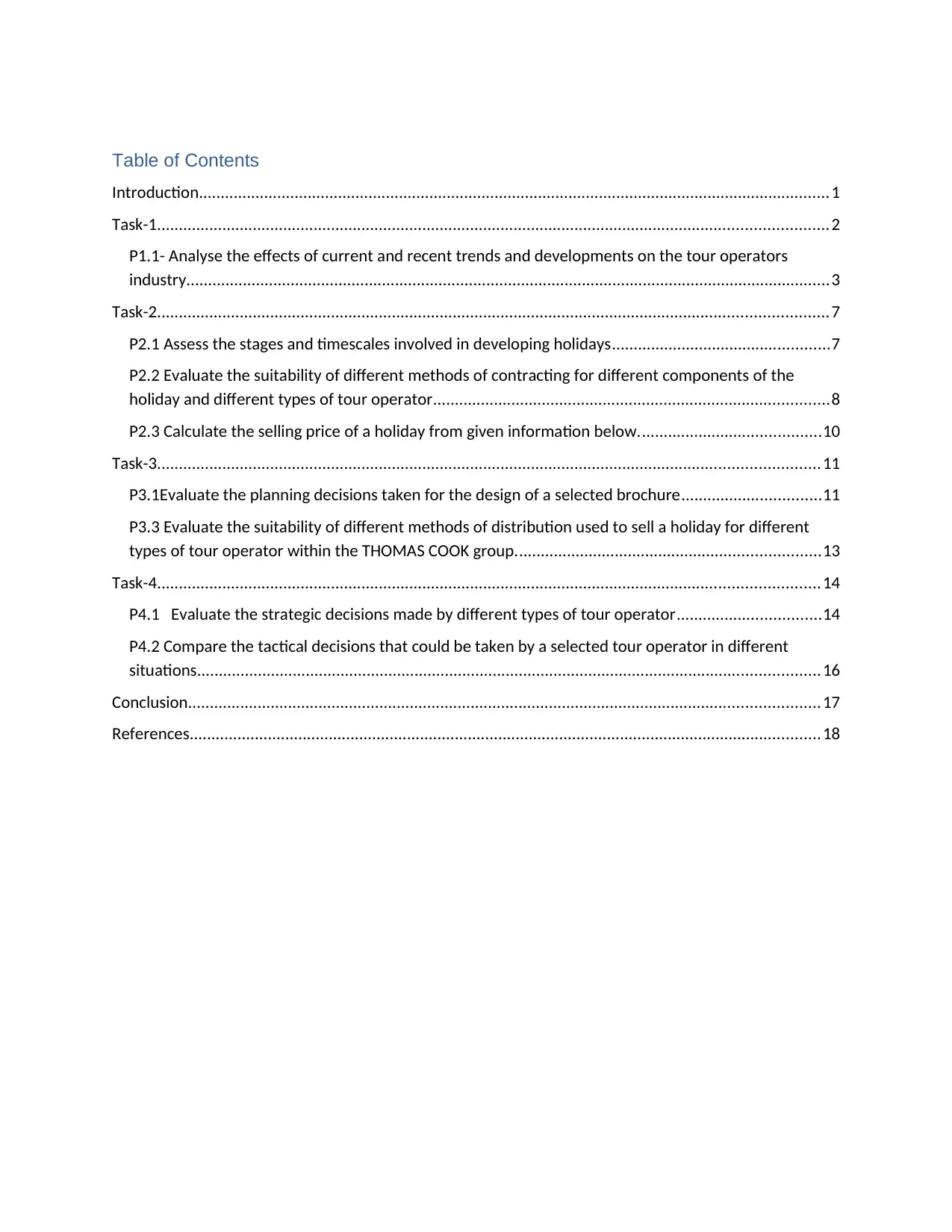
Table of Contents
Introduction.................................................................................................................................................1
Task-1..........................................................................................................................................................2
P1.1- Analyse the effects of current and recent trends and developments on the tour operators
industry....................................................................................................................................................3
Task-2..........................................................................................................................................................7
P2.1 Assess the stages and timescales involved in developing holidays..................................................7
P2.2 Evaluate the suitability of different methods of contracting for different components of the
holiday and different types of tour operator...........................................................................................8
P2.3 Calculate the selling price of a holiday from given information below..........................................10
Task-3........................................................................................................................................................11
P3.1Evaluate the planning decisions taken for the design of a selected brochure................................11
P3.3 Evaluate the suitability of different methods of distribution used to sell a holiday for different
types of tour operator within the THOMAS COOK group......................................................................13
Task-4........................................................................................................................................................14
P4.1 Evaluate the strategic decisions made by different types of tour operator.................................14
P4.2 Compare the tactical decisions that could be taken by a selected tour operator in different
situations...............................................................................................................................................16
Conclusion.................................................................................................................................................17
References.................................................................................................................................................18
Introduction.................................................................................................................................................1
Task-1..........................................................................................................................................................2
P1.1- Analyse the effects of current and recent trends and developments on the tour operators
industry....................................................................................................................................................3
Task-2..........................................................................................................................................................7
P2.1 Assess the stages and timescales involved in developing holidays..................................................7
P2.2 Evaluate the suitability of different methods of contracting for different components of the
holiday and different types of tour operator...........................................................................................8
P2.3 Calculate the selling price of a holiday from given information below..........................................10
Task-3........................................................................................................................................................11
P3.1Evaluate the planning decisions taken for the design of a selected brochure................................11
P3.3 Evaluate the suitability of different methods of distribution used to sell a holiday for different
types of tour operator within the THOMAS COOK group......................................................................13
Task-4........................................................................................................................................................14
P4.1 Evaluate the strategic decisions made by different types of tour operator.................................14
P4.2 Compare the tactical decisions that could be taken by a selected tour operator in different
situations...............................................................................................................................................16
Conclusion.................................................................................................................................................17
References.................................................................................................................................................18
Secure Best Marks with AI Grader
Need help grading? Try our AI Grader for instant feedback on your assignments.
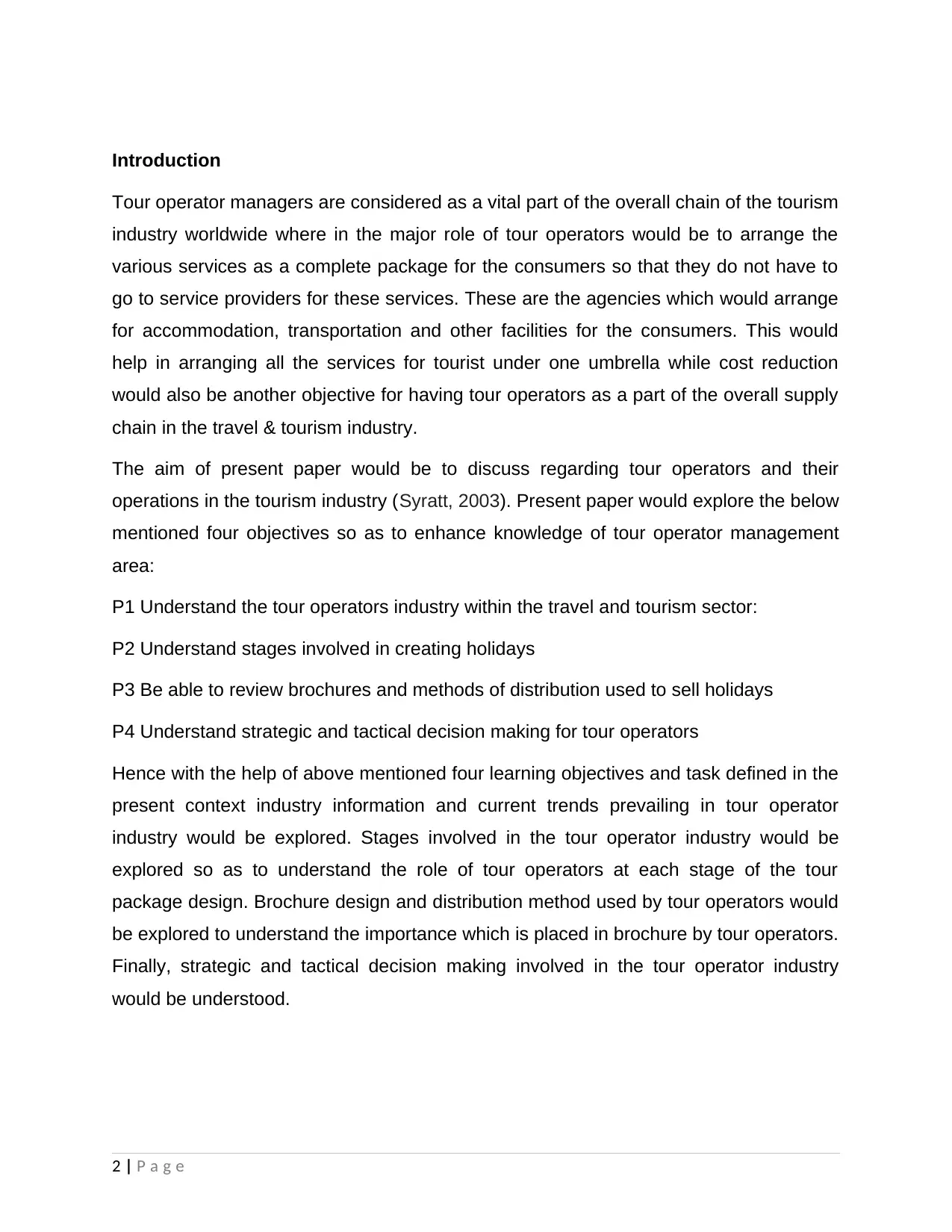
Introduction
Tour operator managers are considered as a vital part of the overall chain of the tourism
industry worldwide where in the major role of tour operators would be to arrange the
various services as a complete package for the consumers so that they do not have to
go to service providers for these services. These are the agencies which would arrange
for accommodation, transportation and other facilities for the consumers. This would
help in arranging all the services for tourist under one umbrella while cost reduction
would also be another objective for having tour operators as a part of the overall supply
chain in the travel & tourism industry.
The aim of present paper would be to discuss regarding tour operators and their
operations in the tourism industry (Syratt, 2003). Present paper would explore the below
mentioned four objectives so as to enhance knowledge of tour operator management
area:
P1 Understand the tour operators industry within the travel and tourism sector:
P2 Understand stages involved in creating holidays
P3 Be able to review brochures and methods of distribution used to sell holidays
P4 Understand strategic and tactical decision making for tour operators
Hence with the help of above mentioned four learning objectives and task defined in the
present context industry information and current trends prevailing in tour operator
industry would be explored. Stages involved in the tour operator industry would be
explored so as to understand the role of tour operators at each stage of the tour
package design. Brochure design and distribution method used by tour operators would
be explored to understand the importance which is placed in brochure by tour operators.
Finally, strategic and tactical decision making involved in the tour operator industry
would be understood.
2 | P a g e
Tour operator managers are considered as a vital part of the overall chain of the tourism
industry worldwide where in the major role of tour operators would be to arrange the
various services as a complete package for the consumers so that they do not have to
go to service providers for these services. These are the agencies which would arrange
for accommodation, transportation and other facilities for the consumers. This would
help in arranging all the services for tourist under one umbrella while cost reduction
would also be another objective for having tour operators as a part of the overall supply
chain in the travel & tourism industry.
The aim of present paper would be to discuss regarding tour operators and their
operations in the tourism industry (Syratt, 2003). Present paper would explore the below
mentioned four objectives so as to enhance knowledge of tour operator management
area:
P1 Understand the tour operators industry within the travel and tourism sector:
P2 Understand stages involved in creating holidays
P3 Be able to review brochures and methods of distribution used to sell holidays
P4 Understand strategic and tactical decision making for tour operators
Hence with the help of above mentioned four learning objectives and task defined in the
present context industry information and current trends prevailing in tour operator
industry would be explored. Stages involved in the tour operator industry would be
explored so as to understand the role of tour operators at each stage of the tour
package design. Brochure design and distribution method used by tour operators would
be explored to understand the importance which is placed in brochure by tour operators.
Finally, strategic and tactical decision making involved in the tour operator industry
would be understood.
2 | P a g e
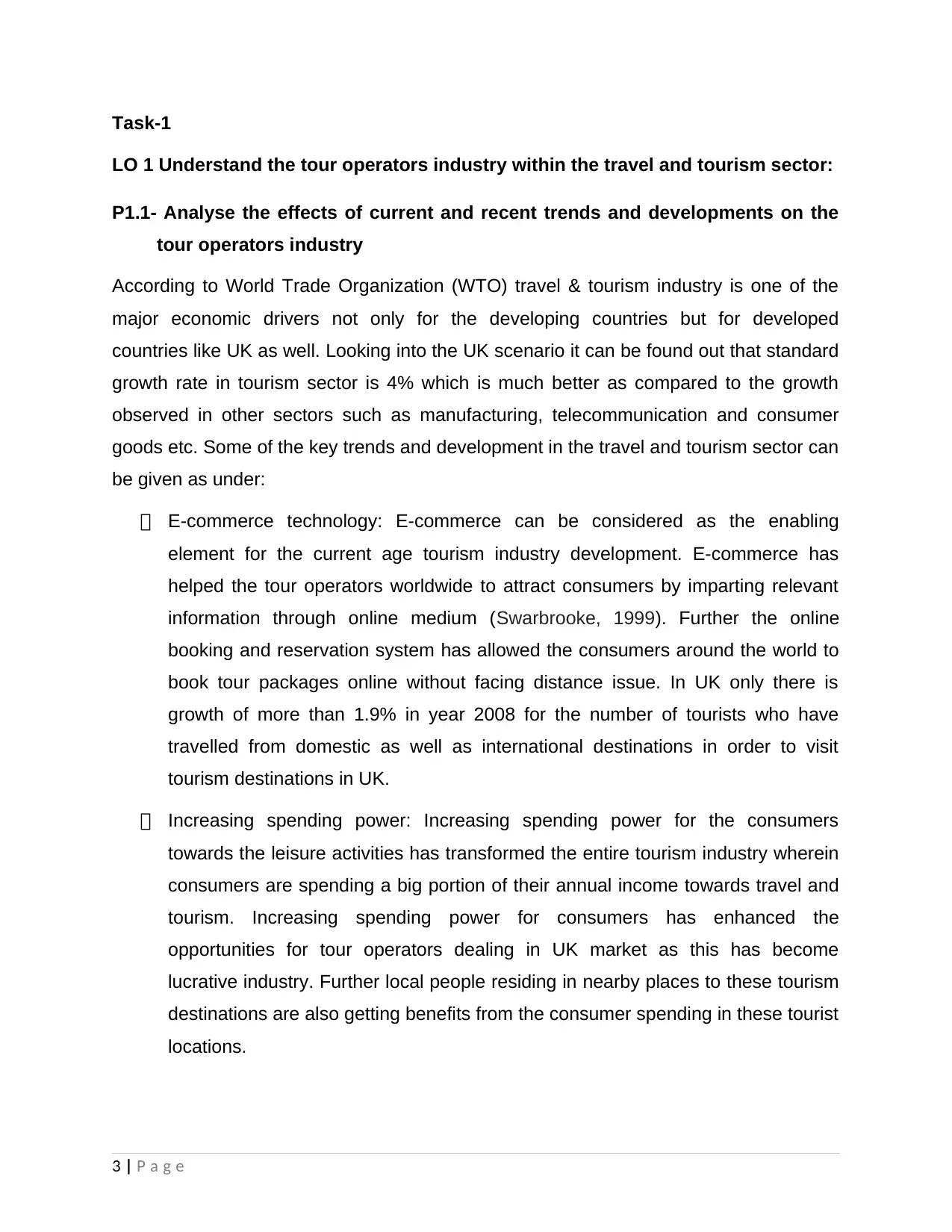
Task-1
LO 1 Understand the tour operators industry within the travel and tourism sector:
P1.1- Analyse the effects of current and recent trends and developments on the
tour operators industry
According to World Trade Organization (WTO) travel & tourism industry is one of the
major economic drivers not only for the developing countries but for developed
countries like UK as well. Looking into the UK scenario it can be found out that standard
growth rate in tourism sector is 4% which is much better as compared to the growth
observed in other sectors such as manufacturing, telecommunication and consumer
goods etc. Some of the key trends and development in the travel and tourism sector can
be given as under:
E-commerce technology: E-commerce can be considered as the enabling
element for the current age tourism industry development. E-commerce has
helped the tour operators worldwide to attract consumers by imparting relevant
information through online medium (Swarbrooke, 1999). Further the online
booking and reservation system has allowed the consumers around the world to
book tour packages online without facing distance issue. In UK only there is
growth of more than 1.9% in year 2008 for the number of tourists who have
travelled from domestic as well as international destinations in order to visit
tourism destinations in UK.
Increasing spending power: Increasing spending power for the consumers
towards the leisure activities has transformed the entire tourism industry wherein
consumers are spending a big portion of their annual income towards travel and
tourism. Increasing spending power for consumers has enhanced the
opportunities for tour operators dealing in UK market as this has become
lucrative industry. Further local people residing in nearby places to these tourism
destinations are also getting benefits from the consumer spending in these tourist
locations.
3 | P a g e
LO 1 Understand the tour operators industry within the travel and tourism sector:
P1.1- Analyse the effects of current and recent trends and developments on the
tour operators industry
According to World Trade Organization (WTO) travel & tourism industry is one of the
major economic drivers not only for the developing countries but for developed
countries like UK as well. Looking into the UK scenario it can be found out that standard
growth rate in tourism sector is 4% which is much better as compared to the growth
observed in other sectors such as manufacturing, telecommunication and consumer
goods etc. Some of the key trends and development in the travel and tourism sector can
be given as under:
E-commerce technology: E-commerce can be considered as the enabling
element for the current age tourism industry development. E-commerce has
helped the tour operators worldwide to attract consumers by imparting relevant
information through online medium (Swarbrooke, 1999). Further the online
booking and reservation system has allowed the consumers around the world to
book tour packages online without facing distance issue. In UK only there is
growth of more than 1.9% in year 2008 for the number of tourists who have
travelled from domestic as well as international destinations in order to visit
tourism destinations in UK.
Increasing spending power: Increasing spending power for the consumers
towards the leisure activities has transformed the entire tourism industry wherein
consumers are spending a big portion of their annual income towards travel and
tourism. Increasing spending power for consumers has enhanced the
opportunities for tour operators dealing in UK market as this has become
lucrative industry. Further local people residing in nearby places to these tourism
destinations are also getting benefits from the consumer spending in these tourist
locations.
3 | P a g e
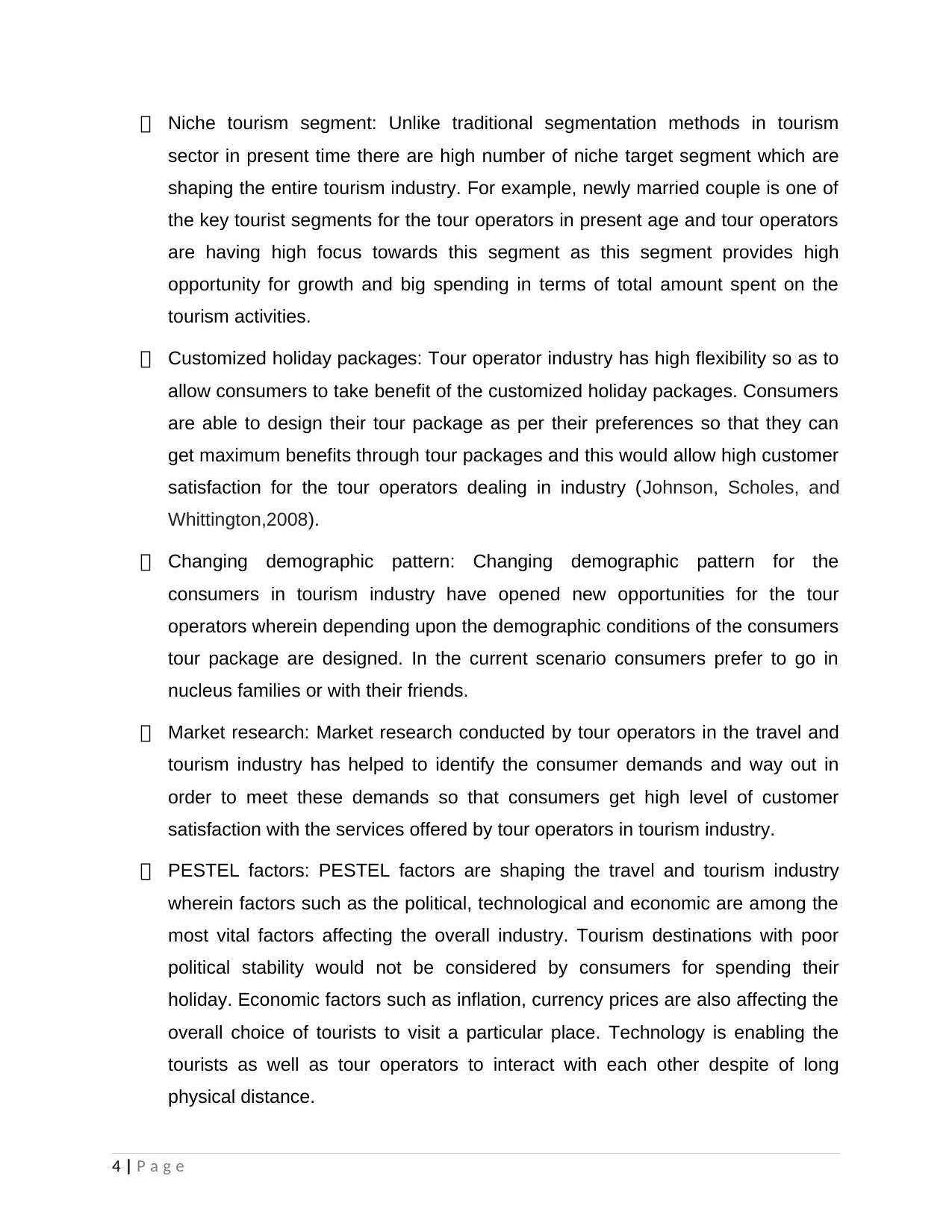
Niche tourism segment: Unlike traditional segmentation methods in tourism
sector in present time there are high number of niche target segment which are
shaping the entire tourism industry. For example, newly married couple is one of
the key tourist segments for the tour operators in present age and tour operators
are having high focus towards this segment as this segment provides high
opportunity for growth and big spending in terms of total amount spent on the
tourism activities.
Customized holiday packages: Tour operator industry has high flexibility so as to
allow consumers to take benefit of the customized holiday packages. Consumers
are able to design their tour package as per their preferences so that they can
get maximum benefits through tour packages and this would allow high customer
satisfaction for the tour operators dealing in industry (Johnson, Scholes, and
Whittington,2008).
Changing demographic pattern: Changing demographic pattern for the
consumers in tourism industry have opened new opportunities for the tour
operators wherein depending upon the demographic conditions of the consumers
tour package are designed. In the current scenario consumers prefer to go in
nucleus families or with their friends.
Market research: Market research conducted by tour operators in the travel and
tourism industry has helped to identify the consumer demands and way out in
order to meet these demands so that consumers get high level of customer
satisfaction with the services offered by tour operators in tourism industry.
PESTEL factors: PESTEL factors are shaping the travel and tourism industry
wherein factors such as the political, technological and economic are among the
most vital factors affecting the overall industry. Tourism destinations with poor
political stability would not be considered by consumers for spending their
holiday. Economic factors such as inflation, currency prices are also affecting the
overall choice of tourists to visit a particular place. Technology is enabling the
tourists as well as tour operators to interact with each other despite of long
physical distance.
4 | P a g e
sector in present time there are high number of niche target segment which are
shaping the entire tourism industry. For example, newly married couple is one of
the key tourist segments for the tour operators in present age and tour operators
are having high focus towards this segment as this segment provides high
opportunity for growth and big spending in terms of total amount spent on the
tourism activities.
Customized holiday packages: Tour operator industry has high flexibility so as to
allow consumers to take benefit of the customized holiday packages. Consumers
are able to design their tour package as per their preferences so that they can
get maximum benefits through tour packages and this would allow high customer
satisfaction for the tour operators dealing in industry (Johnson, Scholes, and
Whittington,2008).
Changing demographic pattern: Changing demographic pattern for the
consumers in tourism industry have opened new opportunities for the tour
operators wherein depending upon the demographic conditions of the consumers
tour package are designed. In the current scenario consumers prefer to go in
nucleus families or with their friends.
Market research: Market research conducted by tour operators in the travel and
tourism industry has helped to identify the consumer demands and way out in
order to meet these demands so that consumers get high level of customer
satisfaction with the services offered by tour operators in tourism industry.
PESTEL factors: PESTEL factors are shaping the travel and tourism industry
wherein factors such as the political, technological and economic are among the
most vital factors affecting the overall industry. Tourism destinations with poor
political stability would not be considered by consumers for spending their
holiday. Economic factors such as inflation, currency prices are also affecting the
overall choice of tourists to visit a particular place. Technology is enabling the
tourists as well as tour operators to interact with each other despite of long
physical distance.
4 | P a g e
Paraphrase This Document
Need a fresh take? Get an instant paraphrase of this document with our AI Paraphraser
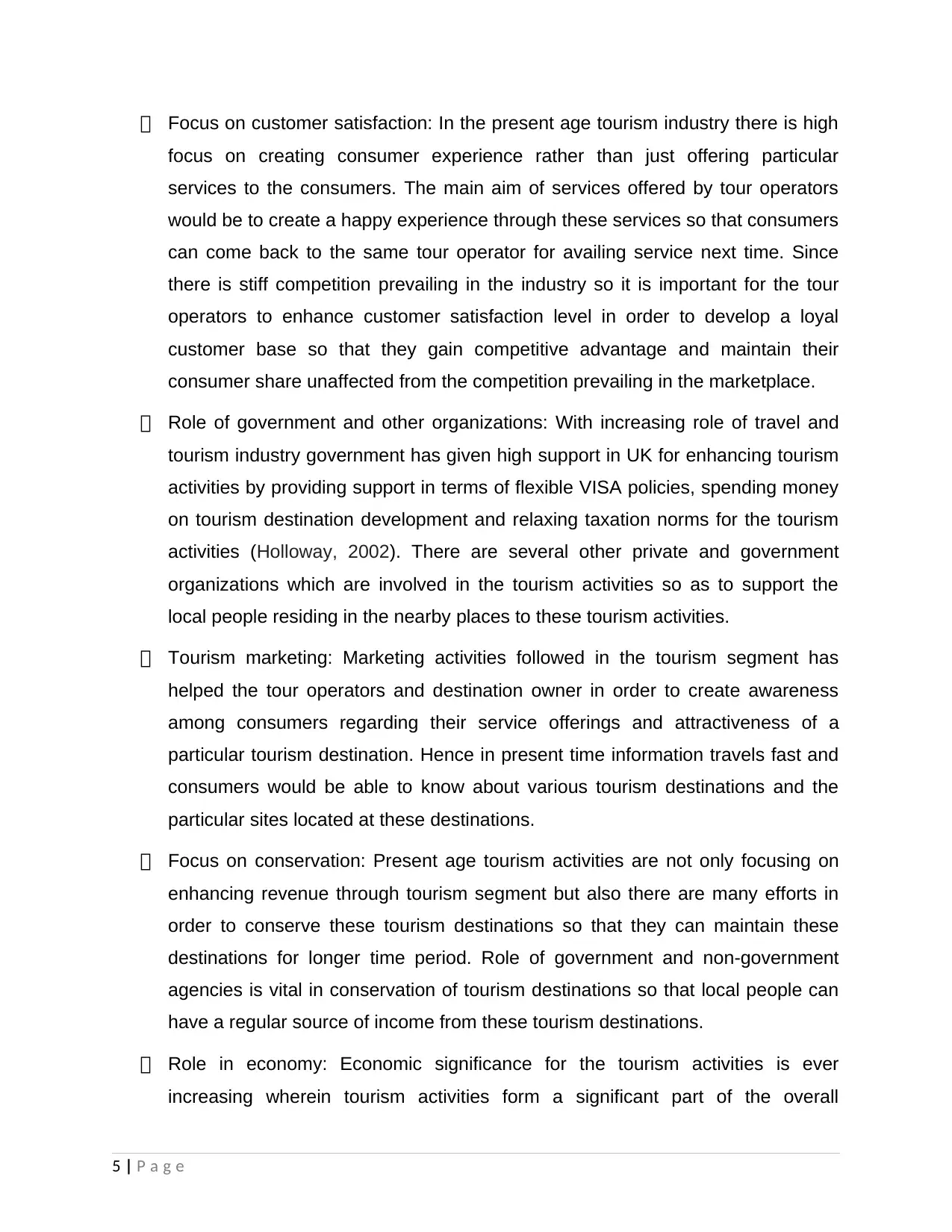
Focus on customer satisfaction: In the present age tourism industry there is high
focus on creating consumer experience rather than just offering particular
services to the consumers. The main aim of services offered by tour operators
would be to create a happy experience through these services so that consumers
can come back to the same tour operator for availing service next time. Since
there is stiff competition prevailing in the industry so it is important for the tour
operators to enhance customer satisfaction level in order to develop a loyal
customer base so that they gain competitive advantage and maintain their
consumer share unaffected from the competition prevailing in the marketplace.
Role of government and other organizations: With increasing role of travel and
tourism industry government has given high support in UK for enhancing tourism
activities by providing support in terms of flexible VISA policies, spending money
on tourism destination development and relaxing taxation norms for the tourism
activities (Holloway, 2002). There are several other private and government
organizations which are involved in the tourism activities so as to support the
local people residing in the nearby places to these tourism activities.
Tourism marketing: Marketing activities followed in the tourism segment has
helped the tour operators and destination owner in order to create awareness
among consumers regarding their service offerings and attractiveness of a
particular tourism destination. Hence in present time information travels fast and
consumers would be able to know about various tourism destinations and the
particular sites located at these destinations.
Focus on conservation: Present age tourism activities are not only focusing on
enhancing revenue through tourism segment but also there are many efforts in
order to conserve these tourism destinations so that they can maintain these
destinations for longer time period. Role of government and non-government
agencies is vital in conservation of tourism destinations so that local people can
have a regular source of income from these tourism destinations.
Role in economy: Economic significance for the tourism activities is ever
increasing wherein tourism activities form a significant part of the overall
5 | P a g e
focus on creating consumer experience rather than just offering particular
services to the consumers. The main aim of services offered by tour operators
would be to create a happy experience through these services so that consumers
can come back to the same tour operator for availing service next time. Since
there is stiff competition prevailing in the industry so it is important for the tour
operators to enhance customer satisfaction level in order to develop a loyal
customer base so that they gain competitive advantage and maintain their
consumer share unaffected from the competition prevailing in the marketplace.
Role of government and other organizations: With increasing role of travel and
tourism industry government has given high support in UK for enhancing tourism
activities by providing support in terms of flexible VISA policies, spending money
on tourism destination development and relaxing taxation norms for the tourism
activities (Holloway, 2002). There are several other private and government
organizations which are involved in the tourism activities so as to support the
local people residing in the nearby places to these tourism activities.
Tourism marketing: Marketing activities followed in the tourism segment has
helped the tour operators and destination owner in order to create awareness
among consumers regarding their service offerings and attractiveness of a
particular tourism destination. Hence in present time information travels fast and
consumers would be able to know about various tourism destinations and the
particular sites located at these destinations.
Focus on conservation: Present age tourism activities are not only focusing on
enhancing revenue through tourism segment but also there are many efforts in
order to conserve these tourism destinations so that they can maintain these
destinations for longer time period. Role of government and non-government
agencies is vital in conservation of tourism destinations so that local people can
have a regular source of income from these tourism destinations.
Role in economy: Economic significance for the tourism activities is ever
increasing wherein tourism activities form a significant part of the overall
5 | P a g e
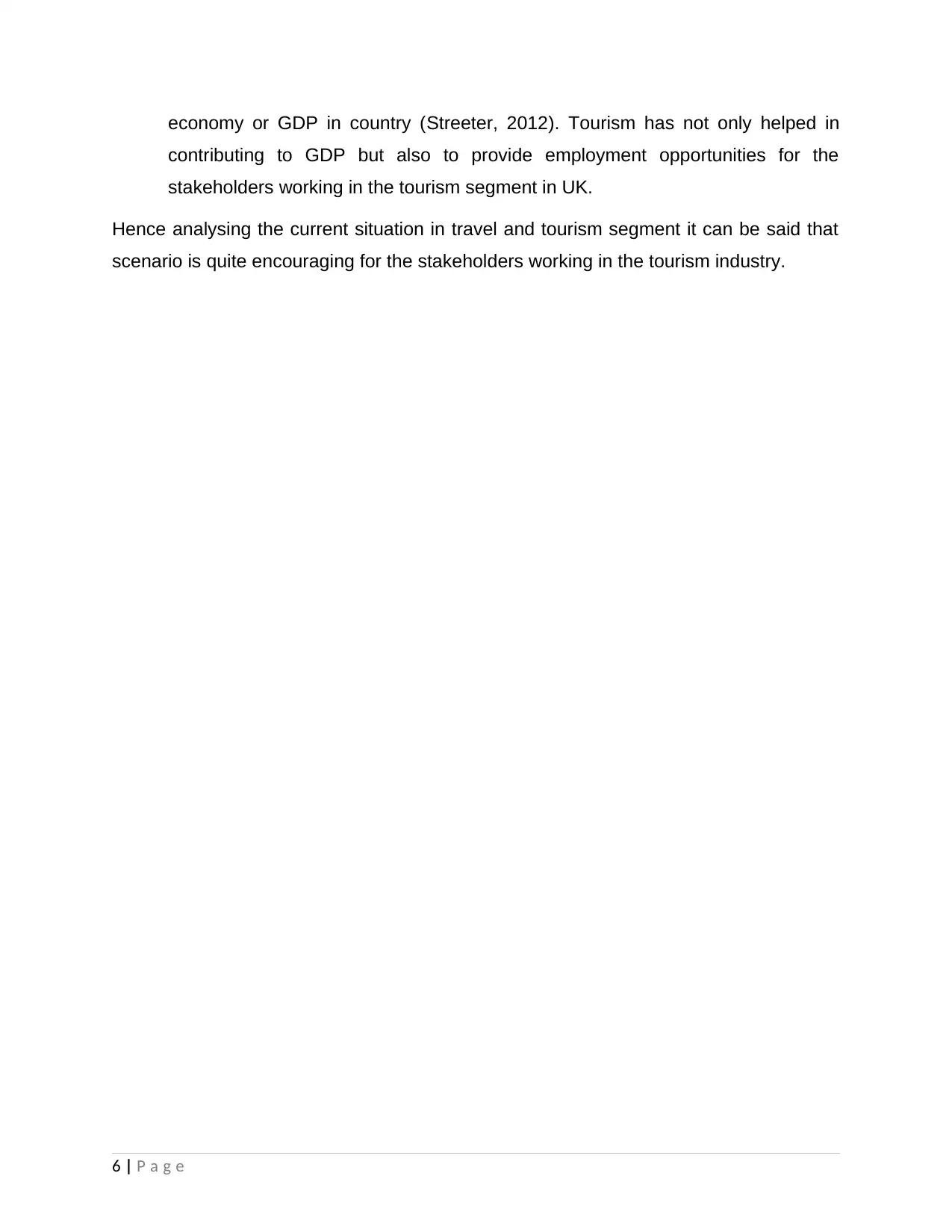
economy or GDP in country (Streeter, 2012). Tourism has not only helped in
contributing to GDP but also to provide employment opportunities for the
stakeholders working in the tourism segment in UK.
Hence analysing the current situation in travel and tourism segment it can be said that
scenario is quite encouraging for the stakeholders working in the tourism industry.
6 | P a g e
contributing to GDP but also to provide employment opportunities for the
stakeholders working in the tourism segment in UK.
Hence analysing the current situation in travel and tourism segment it can be said that
scenario is quite encouraging for the stakeholders working in the tourism industry.
6 | P a g e
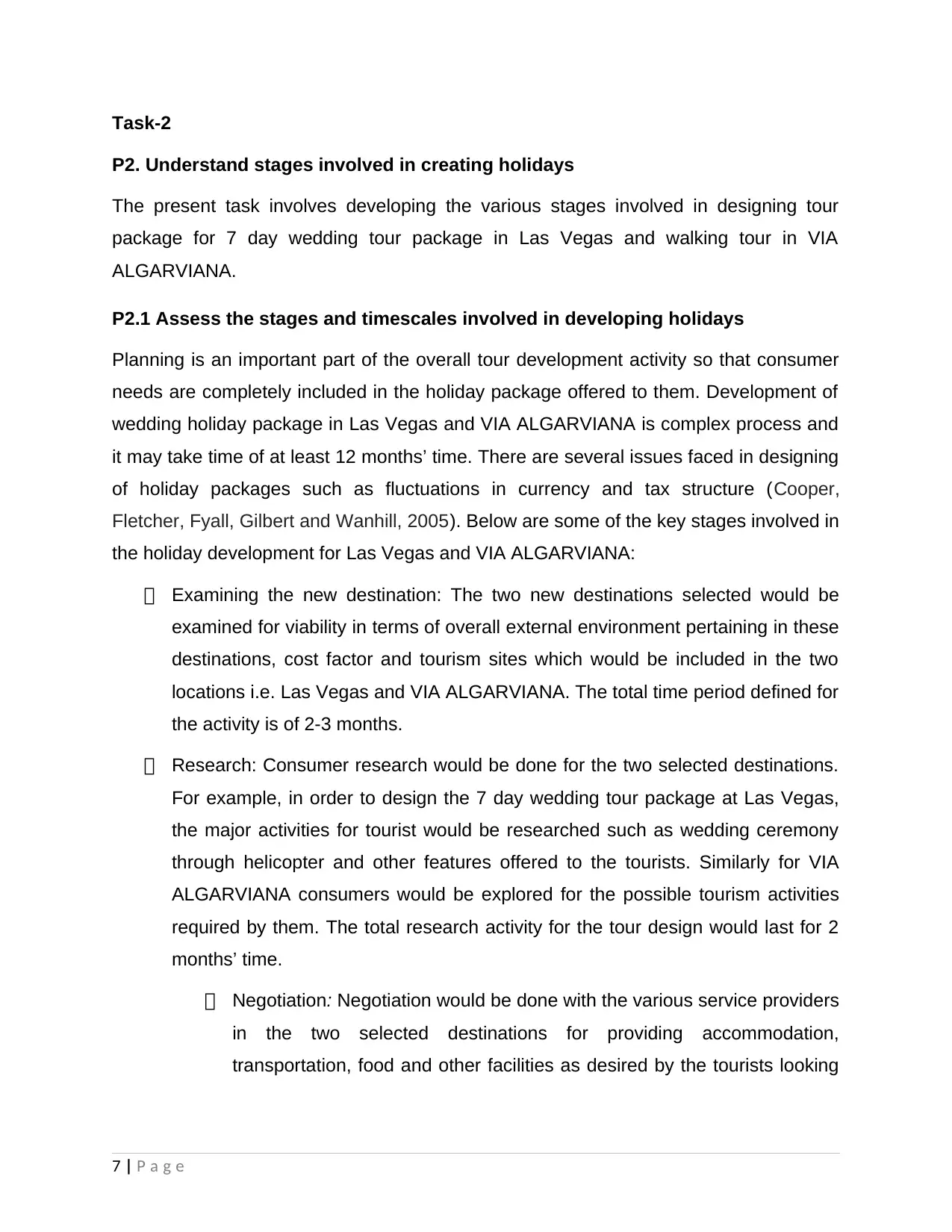
Task-2
P2. Understand stages involved in creating holidays
The present task involves developing the various stages involved in designing tour
package for 7 day wedding tour package in Las Vegas and walking tour in VIA
ALGARVIANA.
P2.1 Assess the stages and timescales involved in developing holidays
Planning is an important part of the overall tour development activity so that consumer
needs are completely included in the holiday package offered to them. Development of
wedding holiday package in Las Vegas and VIA ALGARVIANA is complex process and
it may take time of at least 12 months’ time. There are several issues faced in designing
of holiday packages such as fluctuations in currency and tax structure (Cooper,
Fletcher, Fyall, Gilbert and Wanhill, 2005). Below are some of the key stages involved in
the holiday development for Las Vegas and VIA ALGARVIANA:
Examining the new destination: The two new destinations selected would be
examined for viability in terms of overall external environment pertaining in these
destinations, cost factor and tourism sites which would be included in the two
locations i.e. Las Vegas and VIA ALGARVIANA. The total time period defined for
the activity is of 2-3 months.
Research: Consumer research would be done for the two selected destinations.
For example, in order to design the 7 day wedding tour package at Las Vegas,
the major activities for tourist would be researched such as wedding ceremony
through helicopter and other features offered to the tourists. Similarly for VIA
ALGARVIANA consumers would be explored for the possible tourism activities
required by them. The total research activity for the tour design would last for 2
months’ time.
Negotiation: Negotiation would be done with the various service providers
in the two selected destinations for providing accommodation,
transportation, food and other facilities as desired by the tourists looking
7 | P a g e
P2. Understand stages involved in creating holidays
The present task involves developing the various stages involved in designing tour
package for 7 day wedding tour package in Las Vegas and walking tour in VIA
ALGARVIANA.
P2.1 Assess the stages and timescales involved in developing holidays
Planning is an important part of the overall tour development activity so that consumer
needs are completely included in the holiday package offered to them. Development of
wedding holiday package in Las Vegas and VIA ALGARVIANA is complex process and
it may take time of at least 12 months’ time. There are several issues faced in designing
of holiday packages such as fluctuations in currency and tax structure (Cooper,
Fletcher, Fyall, Gilbert and Wanhill, 2005). Below are some of the key stages involved in
the holiday development for Las Vegas and VIA ALGARVIANA:
Examining the new destination: The two new destinations selected would be
examined for viability in terms of overall external environment pertaining in these
destinations, cost factor and tourism sites which would be included in the two
locations i.e. Las Vegas and VIA ALGARVIANA. The total time period defined for
the activity is of 2-3 months.
Research: Consumer research would be done for the two selected destinations.
For example, in order to design the 7 day wedding tour package at Las Vegas,
the major activities for tourist would be researched such as wedding ceremony
through helicopter and other features offered to the tourists. Similarly for VIA
ALGARVIANA consumers would be explored for the possible tourism activities
required by them. The total research activity for the tour design would last for 2
months’ time.
Negotiation: Negotiation would be done with the various service providers
in the two selected destinations for providing accommodation,
transportation, food and other facilities as desired by the tourists looking
7 | P a g e
Secure Best Marks with AI Grader
Need help grading? Try our AI Grader for instant feedback on your assignments.

for the tour package in these destinations. Process of negotiation is quite
time consuming and would involve time period of 4-5 months.
Tour development: The final step would be development of tour package by
negotiating with service provider and designing tour and communicating the tour
features to the tourists so that promotion can be done for the newly developed
tour package among consumers worldwide. This is the last stage and would
require 2 months time for the development of the tour development.
P2.2 Evaluate the suitability of different methods of contracting for different
components of the holiday and different types of tour operator
In order to book different components of the tour package designed by tour operator
managers mainly two methods are deployed which are sale only contract and fixed
contract. In present task two tour operators i.e. Airtours and Flightcentre would be
compared in order to make different types of contract for the services such as
accommodations, transportation and other services arranged by these tour operators.
The two methods for contracting used by these tour operators can be given as under:
Fixed contract: Fixed contract are made by the service providers in order to
utilize the volume based capacity and at the time of off season so as to
maximize overall income for the service providers in tourism segment. From the
Airtours all inclusive summer package 2014, Airtours have made arrangement
through fixed contract where in based on the expectation for consumers Airtours
have booked the total capacity and payment would be done irrespective of the
capacity utilized. There is risk involved for the non-utilization of capacity and tour
operators would have to pay for the un-utilized part as well (Porter, 2004). But
Airtours has designed this package considering the fact that summer is peak
season for tourist to come for the holiday package and there are very less
chances for non-utilization of capacity hence fixed contract would come with the
added advantage of high discount.
Sale only contract: Another tour operator company selected in present context
i.e. Flight centre would have made the sale only contract for their tour package of
8 | P a g e
time consuming and would involve time period of 4-5 months.
Tour development: The final step would be development of tour package by
negotiating with service provider and designing tour and communicating the tour
features to the tourists so that promotion can be done for the newly developed
tour package among consumers worldwide. This is the last stage and would
require 2 months time for the development of the tour development.
P2.2 Evaluate the suitability of different methods of contracting for different
components of the holiday and different types of tour operator
In order to book different components of the tour package designed by tour operator
managers mainly two methods are deployed which are sale only contract and fixed
contract. In present task two tour operators i.e. Airtours and Flightcentre would be
compared in order to make different types of contract for the services such as
accommodations, transportation and other services arranged by these tour operators.
The two methods for contracting used by these tour operators can be given as under:
Fixed contract: Fixed contract are made by the service providers in order to
utilize the volume based capacity and at the time of off season so as to
maximize overall income for the service providers in tourism segment. From the
Airtours all inclusive summer package 2014, Airtours have made arrangement
through fixed contract where in based on the expectation for consumers Airtours
have booked the total capacity and payment would be done irrespective of the
capacity utilized. There is risk involved for the non-utilization of capacity and tour
operators would have to pay for the un-utilized part as well (Porter, 2004). But
Airtours has designed this package considering the fact that summer is peak
season for tourist to come for the holiday package and there are very less
chances for non-utilization of capacity hence fixed contract would come with the
added advantage of high discount.
Sale only contract: Another tour operator company selected in present context
i.e. Flight centre would have made the sale only contract for their tour package of
8 | P a g e
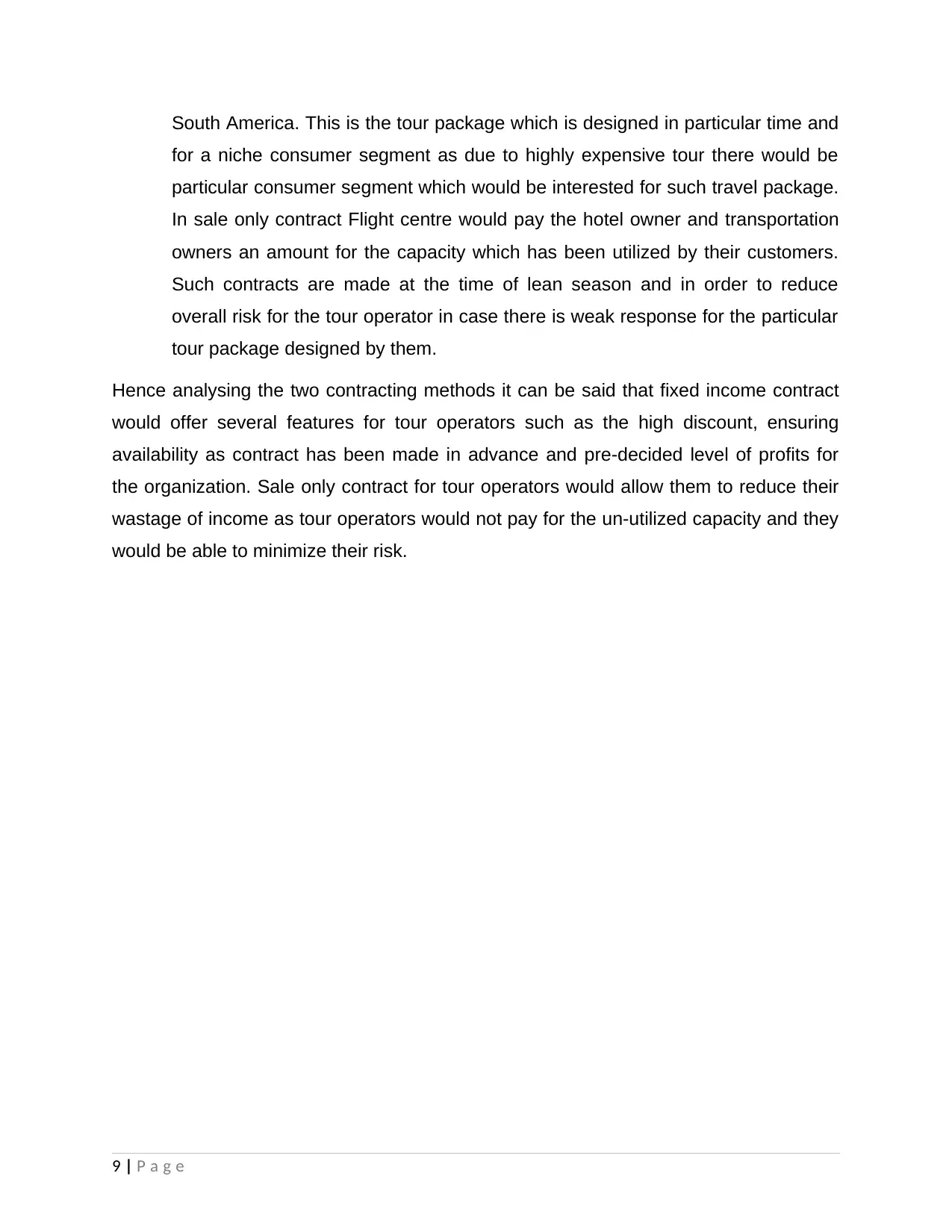
South America. This is the tour package which is designed in particular time and
for a niche consumer segment as due to highly expensive tour there would be
particular consumer segment which would be interested for such travel package.
In sale only contract Flight centre would pay the hotel owner and transportation
owners an amount for the capacity which has been utilized by their customers.
Such contracts are made at the time of lean season and in order to reduce
overall risk for the tour operator in case there is weak response for the particular
tour package designed by them.
Hence analysing the two contracting methods it can be said that fixed income contract
would offer several features for tour operators such as the high discount, ensuring
availability as contract has been made in advance and pre-decided level of profits for
the organization. Sale only contract for tour operators would allow them to reduce their
wastage of income as tour operators would not pay for the un-utilized capacity and they
would be able to minimize their risk.
9 | P a g e
for a niche consumer segment as due to highly expensive tour there would be
particular consumer segment which would be interested for such travel package.
In sale only contract Flight centre would pay the hotel owner and transportation
owners an amount for the capacity which has been utilized by their customers.
Such contracts are made at the time of lean season and in order to reduce
overall risk for the tour operator in case there is weak response for the particular
tour package designed by them.
Hence analysing the two contracting methods it can be said that fixed income contract
would offer several features for tour operators such as the high discount, ensuring
availability as contract has been made in advance and pre-decided level of profits for
the organization. Sale only contract for tour operators would allow them to reduce their
wastage of income as tour operators would not pay for the un-utilized capacity and they
would be able to minimize their risk.
9 | P a g e
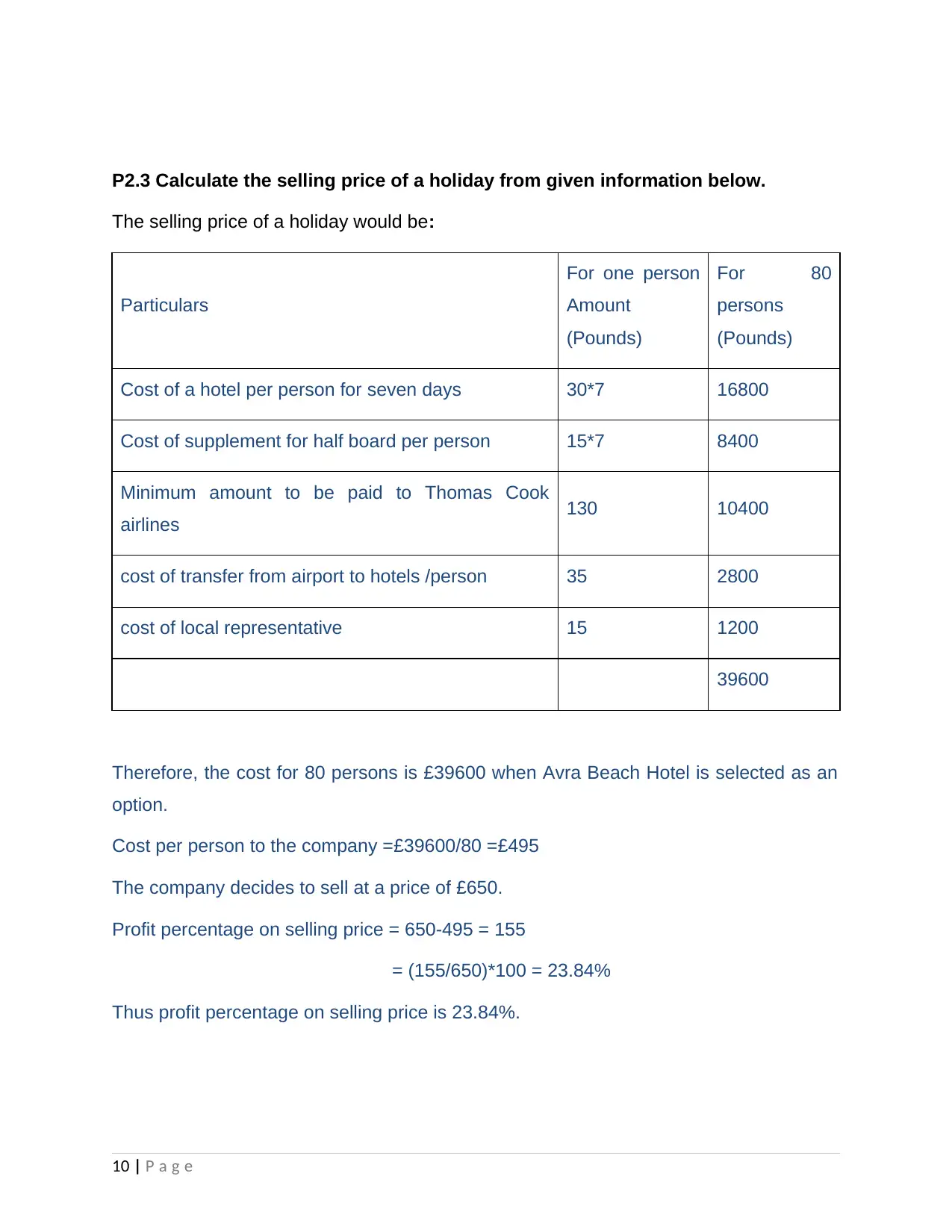
P2.3 Calculate the selling price of a holiday from given information below.
The selling price of a holiday would be:
Particulars
For one person
Amount
(Pounds)
For 80
persons
(Pounds)
Cost of a hotel per person for seven days 30*7 16800
Cost of supplement for half board per person 15*7 8400
Minimum amount to be paid to Thomas Cook
airlines 130 10400
cost of transfer from airport to hotels /person 35 2800
cost of local representative 15 1200
39600
Therefore, the cost for 80 persons is £39600 when Avra Beach Hotel is selected as an
option.
Cost per person to the company =£39600/80 =£495
The company decides to sell at a price of £650.
Profit percentage on selling price = 650-495 = 155
= (155/650)*100 = 23.84%
Thus profit percentage on selling price is 23.84%.
10 | P a g e
The selling price of a holiday would be:
Particulars
For one person
Amount
(Pounds)
For 80
persons
(Pounds)
Cost of a hotel per person for seven days 30*7 16800
Cost of supplement for half board per person 15*7 8400
Minimum amount to be paid to Thomas Cook
airlines 130 10400
cost of transfer from airport to hotels /person 35 2800
cost of local representative 15 1200
39600
Therefore, the cost for 80 persons is £39600 when Avra Beach Hotel is selected as an
option.
Cost per person to the company =£39600/80 =£495
The company decides to sell at a price of £650.
Profit percentage on selling price = 650-495 = 155
= (155/650)*100 = 23.84%
Thus profit percentage on selling price is 23.84%.
10 | P a g e
Paraphrase This Document
Need a fresh take? Get an instant paraphrase of this document with our AI Paraphraser
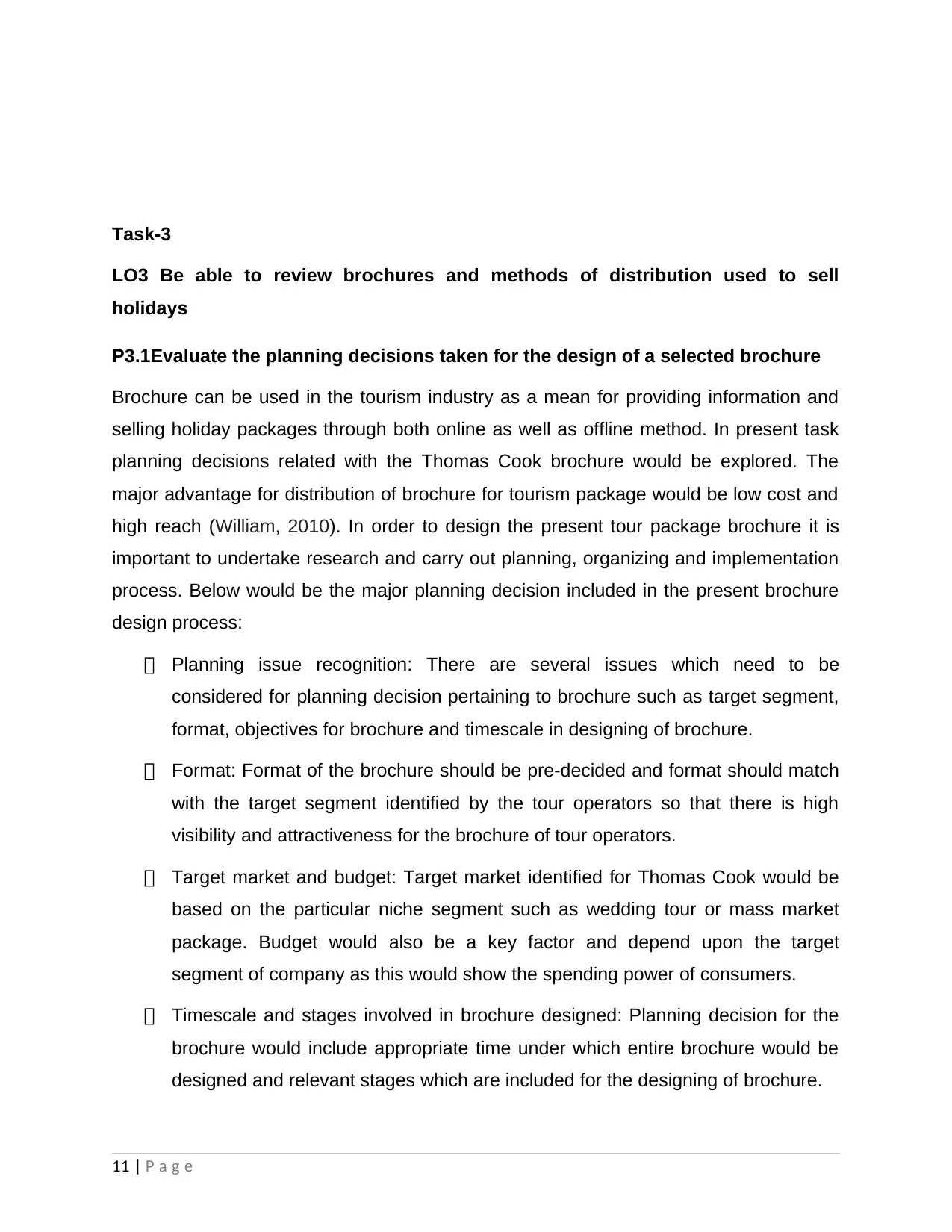
Task-3
LO3 Be able to review brochures and methods of distribution used to sell
holidays
P3.1Evaluate the planning decisions taken for the design of a selected brochure
Brochure can be used in the tourism industry as a mean for providing information and
selling holiday packages through both online as well as offline method. In present task
planning decisions related with the Thomas Cook brochure would be explored. The
major advantage for distribution of brochure for tourism package would be low cost and
high reach (William, 2010). In order to design the present tour package brochure it is
important to undertake research and carry out planning, organizing and implementation
process. Below would be the major planning decision included in the present brochure
design process:
Planning issue recognition: There are several issues which need to be
considered for planning decision pertaining to brochure such as target segment,
format, objectives for brochure and timescale in designing of brochure.
Format: Format of the brochure should be pre-decided and format should match
with the target segment identified by the tour operators so that there is high
visibility and attractiveness for the brochure of tour operators.
Target market and budget: Target market identified for Thomas Cook would be
based on the particular niche segment such as wedding tour or mass market
package. Budget would also be a key factor and depend upon the target
segment of company as this would show the spending power of consumers.
Timescale and stages involved in brochure designed: Planning decision for the
brochure would include appropriate time under which entire brochure would be
designed and relevant stages which are included for the designing of brochure.
11 | P a g e
LO3 Be able to review brochures and methods of distribution used to sell
holidays
P3.1Evaluate the planning decisions taken for the design of a selected brochure
Brochure can be used in the tourism industry as a mean for providing information and
selling holiday packages through both online as well as offline method. In present task
planning decisions related with the Thomas Cook brochure would be explored. The
major advantage for distribution of brochure for tourism package would be low cost and
high reach (William, 2010). In order to design the present tour package brochure it is
important to undertake research and carry out planning, organizing and implementation
process. Below would be the major planning decision included in the present brochure
design process:
Planning issue recognition: There are several issues which need to be
considered for planning decision pertaining to brochure such as target segment,
format, objectives for brochure and timescale in designing of brochure.
Format: Format of the brochure should be pre-decided and format should match
with the target segment identified by the tour operators so that there is high
visibility and attractiveness for the brochure of tour operators.
Target market and budget: Target market identified for Thomas Cook would be
based on the particular niche segment such as wedding tour or mass market
package. Budget would also be a key factor and depend upon the target
segment of company as this would show the spending power of consumers.
Timescale and stages involved in brochure designed: Planning decision for the
brochure would include appropriate time under which entire brochure would be
designed and relevant stages which are included for the designing of brochure.
11 | P a g e

P3.2 Assess the suitability of alternatives to a traditional brochure for the
following tour operators of the THOMAS COOK group: Air Tours, Summer
2014THOMAS Cook Cruises Summer 2014.
Present task would look into providing alternatives for the consumers in order to change
traditional brochure for Thomas Cook cruise summer 2014 and Air Tours summer 2014.
Providing alternatives for the traditional method would help in order to develop the
attractive brochure and higher consumers can be attracted towards the market offerings
of the organization. Traditional brochure has remained a popular medium for sharing
information but with increasing technology in present age it would be suitable for tour
operators that new ways can be developed. E-brochure offers effective medium for
development of brochure and providing information to the customers.
Brochure designed through online method by Airtours and Thomas Cook would be
helpful for these organizations as reach for these brochures would be much wider as
compared to the physical brochure used by the organizations. Another major benefit for
e-brochure would be the low cost medium as online brochures come in much lower cost
as compared to the physical brochure (Kelsey, 2014).Further overall cost required for
the development and design of online brochure would be less as compared to the
physical brochure designed. Visual medium can be one of the suitable alternatives for
these organizations as visual message has high impact and especially for the industries
such as tourism visual brochure would create high impact and would attract the
consumers towards the tour operator offerings.
Information as well as beauty of the tourism destination can be properly presented by
making use of the visual brochures and this would help in enhancing sales for the tour
package designed by the tour operators. Further such video brochure can also be
integrated effectively with the internet marketing tools used by the organizations for the
promotion of their e-brochure. Video brochure designed can be used for promotion
purpose by integrating it with the social media tools such as Facebook and social
sharing tool such as You Tube. Hence looking into the several aspects for the e-
12 | P a g e
following tour operators of the THOMAS COOK group: Air Tours, Summer
2014THOMAS Cook Cruises Summer 2014.
Present task would look into providing alternatives for the consumers in order to change
traditional brochure for Thomas Cook cruise summer 2014 and Air Tours summer 2014.
Providing alternatives for the traditional method would help in order to develop the
attractive brochure and higher consumers can be attracted towards the market offerings
of the organization. Traditional brochure has remained a popular medium for sharing
information but with increasing technology in present age it would be suitable for tour
operators that new ways can be developed. E-brochure offers effective medium for
development of brochure and providing information to the customers.
Brochure designed through online method by Airtours and Thomas Cook would be
helpful for these organizations as reach for these brochures would be much wider as
compared to the physical brochure used by the organizations. Another major benefit for
e-brochure would be the low cost medium as online brochures come in much lower cost
as compared to the physical brochure (Kelsey, 2014).Further overall cost required for
the development and design of online brochure would be less as compared to the
physical brochure designed. Visual medium can be one of the suitable alternatives for
these organizations as visual message has high impact and especially for the industries
such as tourism visual brochure would create high impact and would attract the
consumers towards the tour operator offerings.
Information as well as beauty of the tourism destination can be properly presented by
making use of the visual brochures and this would help in enhancing sales for the tour
package designed by the tour operators. Further such video brochure can also be
integrated effectively with the internet marketing tools used by the organizations for the
promotion of their e-brochure. Video brochure designed can be used for promotion
purpose by integrating it with the social media tools such as Facebook and social
sharing tool such as You Tube. Hence looking into the several aspects for the e-
12 | P a g e
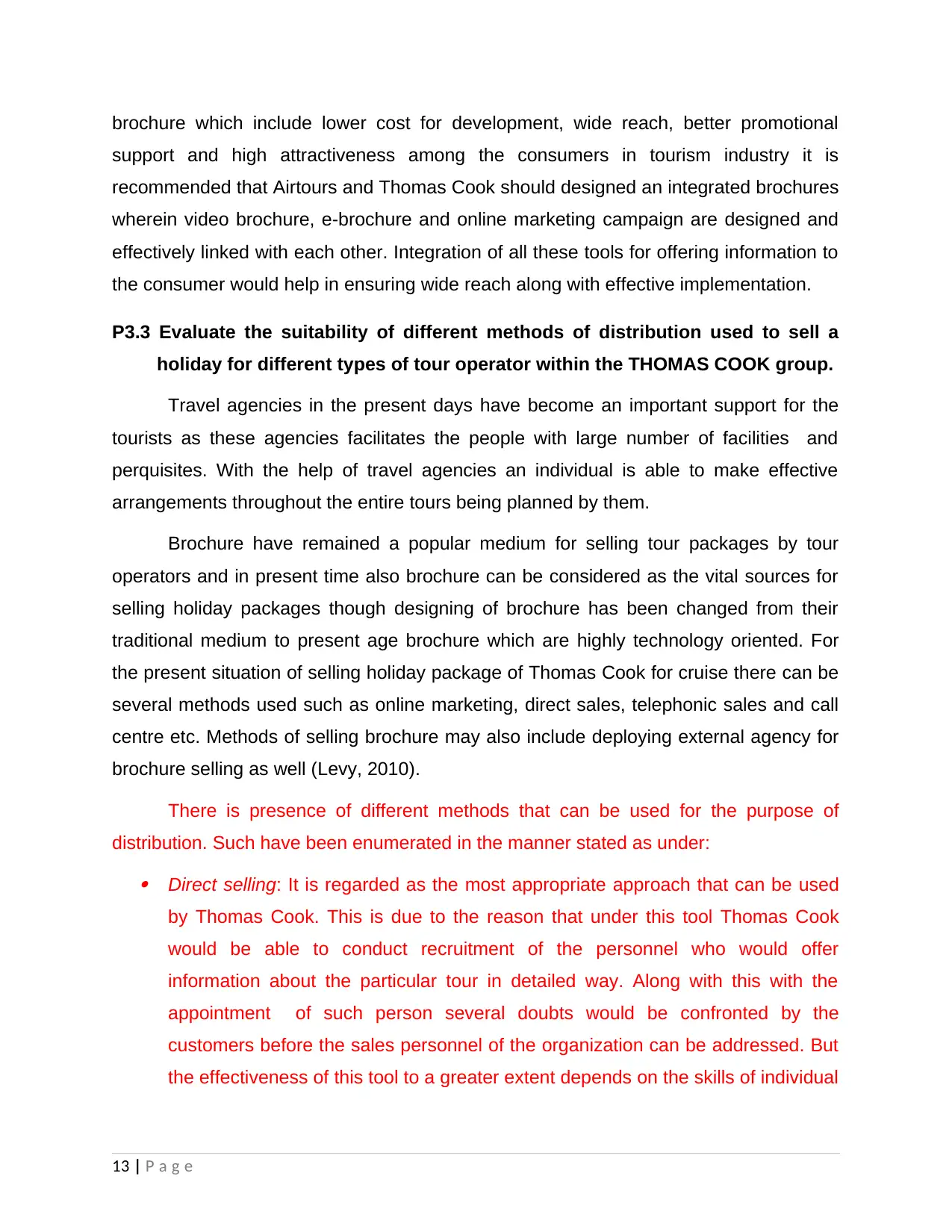
brochure which include lower cost for development, wide reach, better promotional
support and high attractiveness among the consumers in tourism industry it is
recommended that Airtours and Thomas Cook should designed an integrated brochures
wherein video brochure, e-brochure and online marketing campaign are designed and
effectively linked with each other. Integration of all these tools for offering information to
the consumer would help in ensuring wide reach along with effective implementation.
P3.3 Evaluate the suitability of different methods of distribution used to sell a
holiday for different types of tour operator within the THOMAS COOK group.
Travel agencies in the present days have become an important support for the
tourists as these agencies facilitates the people with large number of facilities and
perquisites. With the help of travel agencies an individual is able to make effective
arrangements throughout the entire tours being planned by them.
Brochure have remained a popular medium for selling tour packages by tour
operators and in present time also brochure can be considered as the vital sources for
selling holiday packages though designing of brochure has been changed from their
traditional medium to present age brochure which are highly technology oriented. For
the present situation of selling holiday package of Thomas Cook for cruise there can be
several methods used such as online marketing, direct sales, telephonic sales and call
centre etc. Methods of selling brochure may also include deploying external agency for
brochure selling as well (Levy, 2010).
There is presence of different methods that can be used for the purpose of
distribution. Such have been enumerated in the manner stated as under: Direct selling: It is regarded as the most appropriate approach that can be used
by Thomas Cook. This is due to the reason that under this tool Thomas Cook
would be able to conduct recruitment of the personnel who would offer
information about the particular tour in detailed way. Along with this with the
appointment of such person several doubts would be confronted by the
customers before the sales personnel of the organization can be addressed. But
the effectiveness of this tool to a greater extent depends on the skills of individual
13 | P a g e
support and high attractiveness among the consumers in tourism industry it is
recommended that Airtours and Thomas Cook should designed an integrated brochures
wherein video brochure, e-brochure and online marketing campaign are designed and
effectively linked with each other. Integration of all these tools for offering information to
the consumer would help in ensuring wide reach along with effective implementation.
P3.3 Evaluate the suitability of different methods of distribution used to sell a
holiday for different types of tour operator within the THOMAS COOK group.
Travel agencies in the present days have become an important support for the
tourists as these agencies facilitates the people with large number of facilities and
perquisites. With the help of travel agencies an individual is able to make effective
arrangements throughout the entire tours being planned by them.
Brochure have remained a popular medium for selling tour packages by tour
operators and in present time also brochure can be considered as the vital sources for
selling holiday packages though designing of brochure has been changed from their
traditional medium to present age brochure which are highly technology oriented. For
the present situation of selling holiday package of Thomas Cook for cruise there can be
several methods used such as online marketing, direct sales, telephonic sales and call
centre etc. Methods of selling brochure may also include deploying external agency for
brochure selling as well (Levy, 2010).
There is presence of different methods that can be used for the purpose of
distribution. Such have been enumerated in the manner stated as under: Direct selling: It is regarded as the most appropriate approach that can be used
by Thomas Cook. This is due to the reason that under this tool Thomas Cook
would be able to conduct recruitment of the personnel who would offer
information about the particular tour in detailed way. Along with this with the
appointment of such person several doubts would be confronted by the
customers before the sales personnel of the organization can be addressed. But
the effectiveness of this tool to a greater extent depends on the skills of individual
13 | P a g e
Secure Best Marks with AI Grader
Need help grading? Try our AI Grader for instant feedback on your assignments.
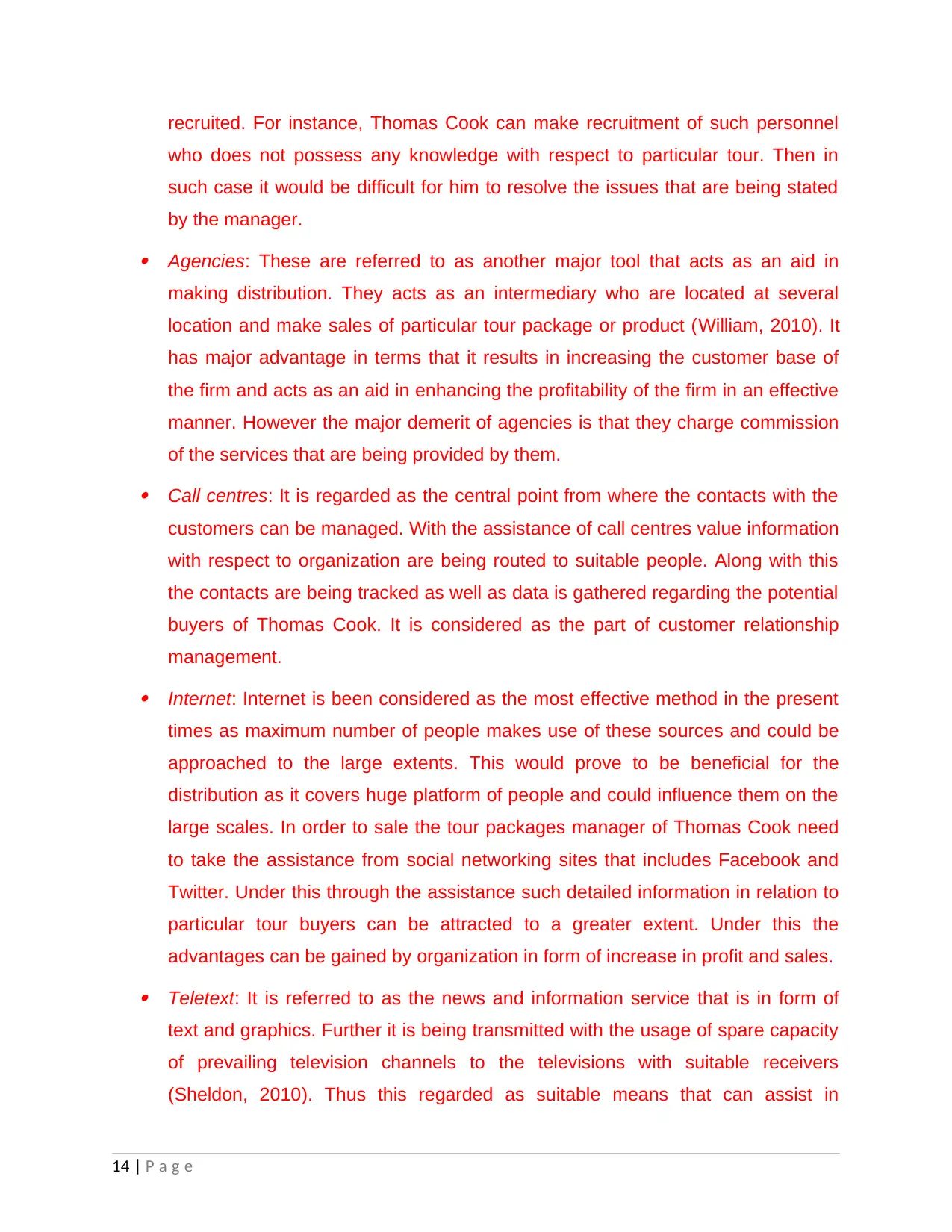
recruited. For instance, Thomas Cook can make recruitment of such personnel
who does not possess any knowledge with respect to particular tour. Then in
such case it would be difficult for him to resolve the issues that are being stated
by the manager. Agencies: These are referred to as another major tool that acts as an aid in
making distribution. They acts as an intermediary who are located at several
location and make sales of particular tour package or product (William, 2010). It
has major advantage in terms that it results in increasing the customer base of
the firm and acts as an aid in enhancing the profitability of the firm in an effective
manner. However the major demerit of agencies is that they charge commission
of the services that are being provided by them. Call centres: It is regarded as the central point from where the contacts with the
customers can be managed. With the assistance of call centres value information
with respect to organization are being routed to suitable people. Along with this
the contacts are being tracked as well as data is gathered regarding the potential
buyers of Thomas Cook. It is considered as the part of customer relationship
management. Internet: Internet is been considered as the most effective method in the present
times as maximum number of people makes use of these sources and could be
approached to the large extents. This would prove to be beneficial for the
distribution as it covers huge platform of people and could influence them on the
large scales. In order to sale the tour packages manager of Thomas Cook need
to take the assistance from social networking sites that includes Facebook and
Twitter. Under this through the assistance such detailed information in relation to
particular tour buyers can be attracted to a greater extent. Under this the
advantages can be gained by organization in form of increase in profit and sales. Teletext: It is referred to as the news and information service that is in form of
text and graphics. Further it is being transmitted with the usage of spare capacity
of prevailing television channels to the televisions with suitable receivers
(Sheldon, 2010). Thus this regarded as suitable means that can assist in
14 | P a g e
who does not possess any knowledge with respect to particular tour. Then in
such case it would be difficult for him to resolve the issues that are being stated
by the manager. Agencies: These are referred to as another major tool that acts as an aid in
making distribution. They acts as an intermediary who are located at several
location and make sales of particular tour package or product (William, 2010). It
has major advantage in terms that it results in increasing the customer base of
the firm and acts as an aid in enhancing the profitability of the firm in an effective
manner. However the major demerit of agencies is that they charge commission
of the services that are being provided by them. Call centres: It is regarded as the central point from where the contacts with the
customers can be managed. With the assistance of call centres value information
with respect to organization are being routed to suitable people. Along with this
the contacts are being tracked as well as data is gathered regarding the potential
buyers of Thomas Cook. It is considered as the part of customer relationship
management. Internet: Internet is been considered as the most effective method in the present
times as maximum number of people makes use of these sources and could be
approached to the large extents. This would prove to be beneficial for the
distribution as it covers huge platform of people and could influence them on the
large scales. In order to sale the tour packages manager of Thomas Cook need
to take the assistance from social networking sites that includes Facebook and
Twitter. Under this through the assistance such detailed information in relation to
particular tour buyers can be attracted to a greater extent. Under this the
advantages can be gained by organization in form of increase in profit and sales. Teletext: It is referred to as the news and information service that is in form of
text and graphics. Further it is being transmitted with the usage of spare capacity
of prevailing television channels to the televisions with suitable receivers
(Sheldon, 2010). Thus this regarded as suitable means that can assist in
14 | P a g e
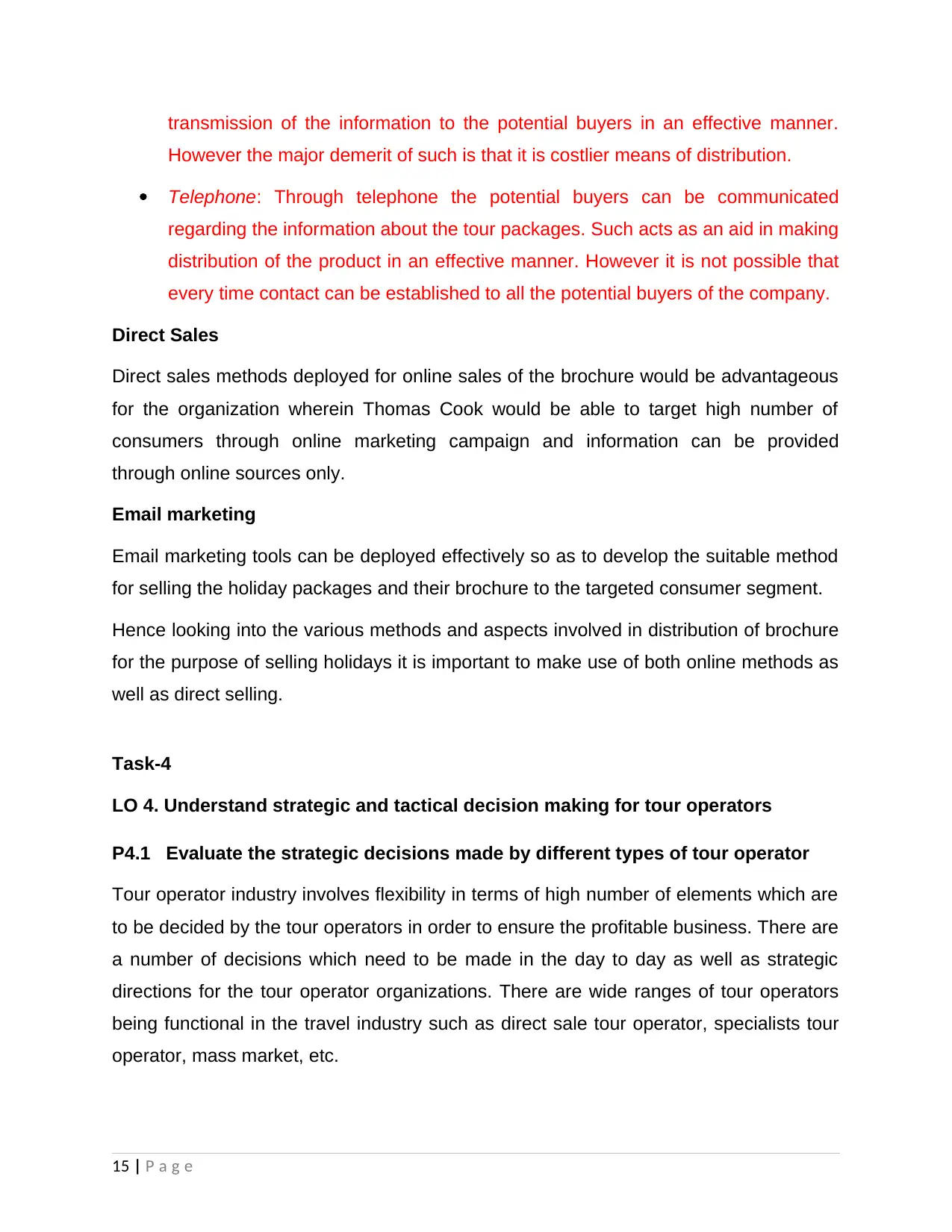
transmission of the information to the potential buyers in an effective manner.
However the major demerit of such is that it is costlier means of distribution.
Telephone: Through telephone the potential buyers can be communicated
regarding the information about the tour packages. Such acts as an aid in making
distribution of the product in an effective manner. However it is not possible that
every time contact can be established to all the potential buyers of the company.
Direct Sales
Direct sales methods deployed for online sales of the brochure would be advantageous
for the organization wherein Thomas Cook would be able to target high number of
consumers through online marketing campaign and information can be provided
through online sources only.
Email marketing
Email marketing tools can be deployed effectively so as to develop the suitable method
for selling the holiday packages and their brochure to the targeted consumer segment.
Hence looking into the various methods and aspects involved in distribution of brochure
for the purpose of selling holidays it is important to make use of both online methods as
well as direct selling.
Task-4
LO 4. Understand strategic and tactical decision making for tour operators
P4.1 Evaluate the strategic decisions made by different types of tour operator
Tour operator industry involves flexibility in terms of high number of elements which are
to be decided by the tour operators in order to ensure the profitable business. There are
a number of decisions which need to be made in the day to day as well as strategic
directions for the tour operator organizations. There are wide ranges of tour operators
being functional in the travel industry such as direct sale tour operator, specialists tour
operator, mass market, etc.
15 | P a g e
However the major demerit of such is that it is costlier means of distribution.
Telephone: Through telephone the potential buyers can be communicated
regarding the information about the tour packages. Such acts as an aid in making
distribution of the product in an effective manner. However it is not possible that
every time contact can be established to all the potential buyers of the company.
Direct Sales
Direct sales methods deployed for online sales of the brochure would be advantageous
for the organization wherein Thomas Cook would be able to target high number of
consumers through online marketing campaign and information can be provided
through online sources only.
Email marketing
Email marketing tools can be deployed effectively so as to develop the suitable method
for selling the holiday packages and their brochure to the targeted consumer segment.
Hence looking into the various methods and aspects involved in distribution of brochure
for the purpose of selling holidays it is important to make use of both online methods as
well as direct selling.
Task-4
LO 4. Understand strategic and tactical decision making for tour operators
P4.1 Evaluate the strategic decisions made by different types of tour operator
Tour operator industry involves flexibility in terms of high number of elements which are
to be decided by the tour operators in order to ensure the profitable business. There are
a number of decisions which need to be made in the day to day as well as strategic
directions for the tour operator organizations. There are wide ranges of tour operators
being functional in the travel industry such as direct sale tour operator, specialists tour
operator, mass market, etc.
15 | P a g e
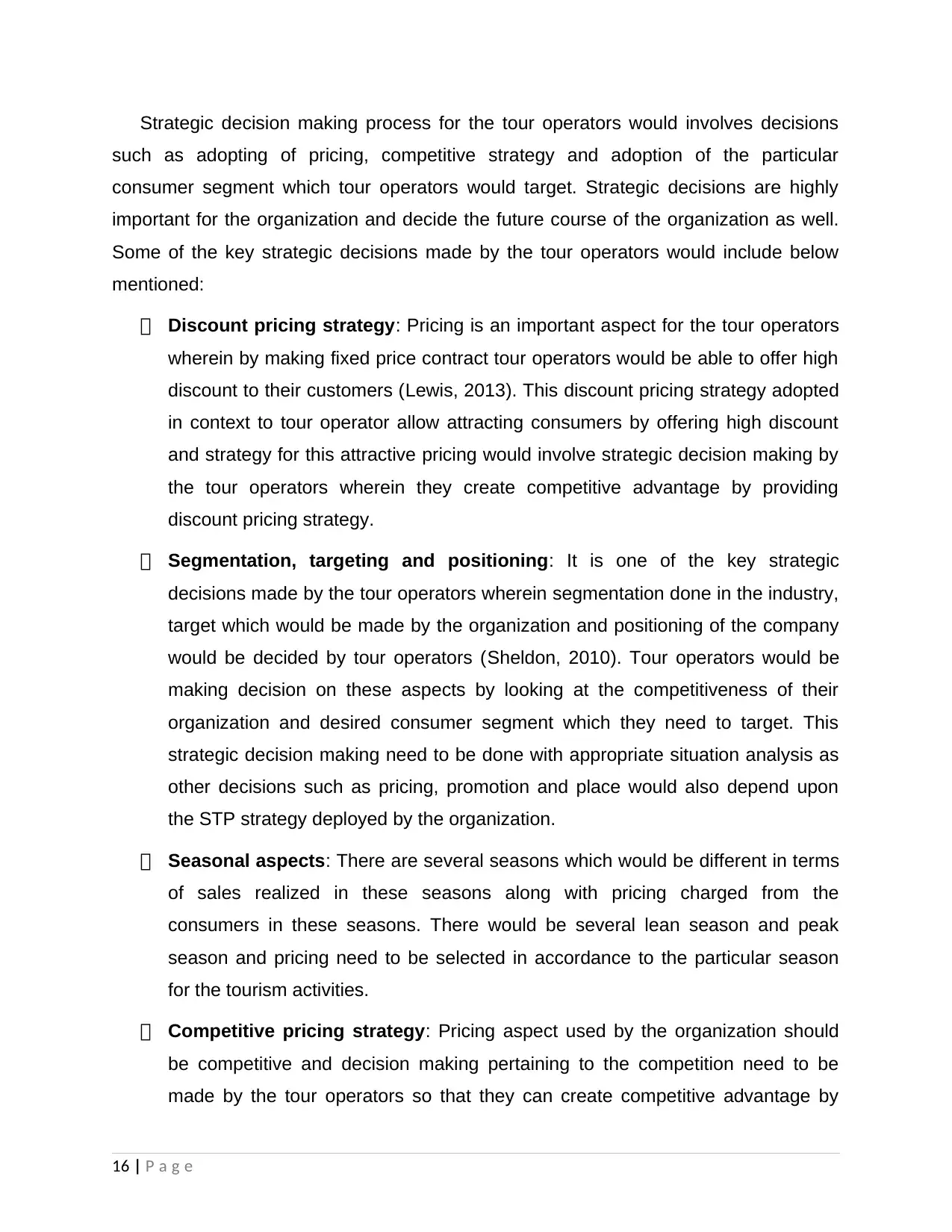
Strategic decision making process for the tour operators would involves decisions
such as adopting of pricing, competitive strategy and adoption of the particular
consumer segment which tour operators would target. Strategic decisions are highly
important for the organization and decide the future course of the organization as well.
Some of the key strategic decisions made by the tour operators would include below
mentioned:
Discount pricing strategy: Pricing is an important aspect for the tour operators
wherein by making fixed price contract tour operators would be able to offer high
discount to their customers (Lewis, 2013). This discount pricing strategy adopted
in context to tour operator allow attracting consumers by offering high discount
and strategy for this attractive pricing would involve strategic decision making by
the tour operators wherein they create competitive advantage by providing
discount pricing strategy.
Segmentation, targeting and positioning: It is one of the key strategic
decisions made by the tour operators wherein segmentation done in the industry,
target which would be made by the organization and positioning of the company
would be decided by tour operators (Sheldon, 2010). Tour operators would be
making decision on these aspects by looking at the competitiveness of their
organization and desired consumer segment which they need to target. This
strategic decision making need to be done with appropriate situation analysis as
other decisions such as pricing, promotion and place would also depend upon
the STP strategy deployed by the organization.
Seasonal aspects: There are several seasons which would be different in terms
of sales realized in these seasons along with pricing charged from the
consumers in these seasons. There would be several lean season and peak
season and pricing need to be selected in accordance to the particular season
for the tourism activities.
Competitive pricing strategy: Pricing aspect used by the organization should
be competitive and decision making pertaining to the competition need to be
made by the tour operators so that they can create competitive advantage by
16 | P a g e
such as adopting of pricing, competitive strategy and adoption of the particular
consumer segment which tour operators would target. Strategic decisions are highly
important for the organization and decide the future course of the organization as well.
Some of the key strategic decisions made by the tour operators would include below
mentioned:
Discount pricing strategy: Pricing is an important aspect for the tour operators
wherein by making fixed price contract tour operators would be able to offer high
discount to their customers (Lewis, 2013). This discount pricing strategy adopted
in context to tour operator allow attracting consumers by offering high discount
and strategy for this attractive pricing would involve strategic decision making by
the tour operators wherein they create competitive advantage by providing
discount pricing strategy.
Segmentation, targeting and positioning: It is one of the key strategic
decisions made by the tour operators wherein segmentation done in the industry,
target which would be made by the organization and positioning of the company
would be decided by tour operators (Sheldon, 2010). Tour operators would be
making decision on these aspects by looking at the competitiveness of their
organization and desired consumer segment which they need to target. This
strategic decision making need to be done with appropriate situation analysis as
other decisions such as pricing, promotion and place would also depend upon
the STP strategy deployed by the organization.
Seasonal aspects: There are several seasons which would be different in terms
of sales realized in these seasons along with pricing charged from the
consumers in these seasons. There would be several lean season and peak
season and pricing need to be selected in accordance to the particular season
for the tourism activities.
Competitive pricing strategy: Pricing aspect used by the organization should
be competitive and decision making pertaining to the competition need to be
made by the tour operators so that they can create competitive advantage by
16 | P a g e
Paraphrase This Document
Need a fresh take? Get an instant paraphrase of this document with our AI Paraphraser
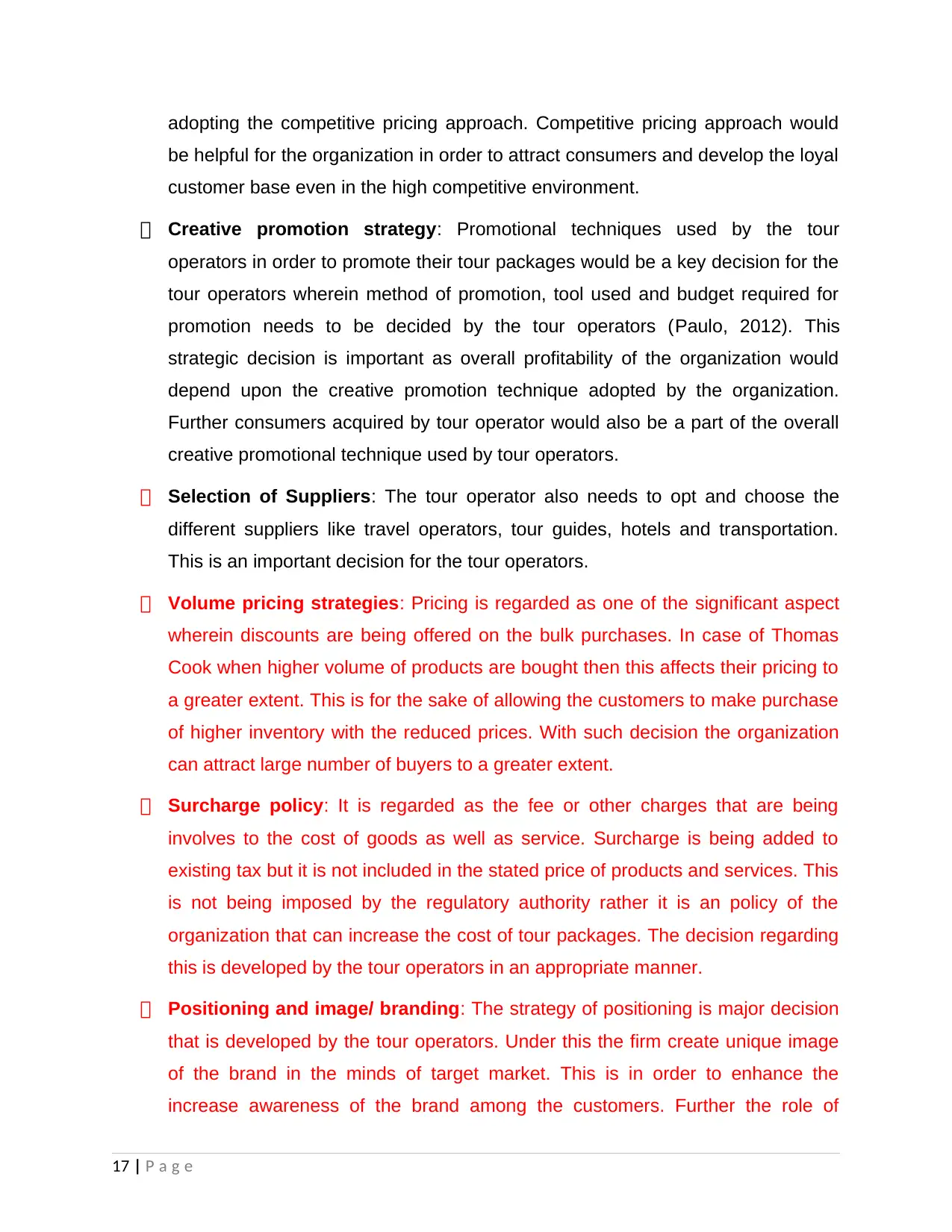
adopting the competitive pricing approach. Competitive pricing approach would
be helpful for the organization in order to attract consumers and develop the loyal
customer base even in the high competitive environment.
Creative promotion strategy: Promotional techniques used by the tour
operators in order to promote their tour packages would be a key decision for the
tour operators wherein method of promotion, tool used and budget required for
promotion needs to be decided by the tour operators (Paulo, 2012). This
strategic decision is important as overall profitability of the organization would
depend upon the creative promotion technique adopted by the organization.
Further consumers acquired by tour operator would also be a part of the overall
creative promotional technique used by tour operators.
Selection of Suppliers: The tour operator also needs to opt and choose the
different suppliers like travel operators, tour guides, hotels and transportation.
This is an important decision for the tour operators.
Volume pricing strategies: Pricing is regarded as one of the significant aspect
wherein discounts are being offered on the bulk purchases. In case of Thomas
Cook when higher volume of products are bought then this affects their pricing to
a greater extent. This is for the sake of allowing the customers to make purchase
of higher inventory with the reduced prices. With such decision the organization
can attract large number of buyers to a greater extent.
Surcharge policy: It is regarded as the fee or other charges that are being
involves to the cost of goods as well as service. Surcharge is being added to
existing tax but it is not included in the stated price of products and services. This
is not being imposed by the regulatory authority rather it is an policy of the
organization that can increase the cost of tour packages. The decision regarding
this is developed by the tour operators in an appropriate manner.
Positioning and image/ branding: The strategy of positioning is major decision
that is developed by the tour operators. Under this the firm create unique image
of the brand in the minds of target market. This is in order to enhance the
increase awareness of the brand among the customers. Further the role of
17 | P a g e
be helpful for the organization in order to attract consumers and develop the loyal
customer base even in the high competitive environment.
Creative promotion strategy: Promotional techniques used by the tour
operators in order to promote their tour packages would be a key decision for the
tour operators wherein method of promotion, tool used and budget required for
promotion needs to be decided by the tour operators (Paulo, 2012). This
strategic decision is important as overall profitability of the organization would
depend upon the creative promotion technique adopted by the organization.
Further consumers acquired by tour operator would also be a part of the overall
creative promotional technique used by tour operators.
Selection of Suppliers: The tour operator also needs to opt and choose the
different suppliers like travel operators, tour guides, hotels and transportation.
This is an important decision for the tour operators.
Volume pricing strategies: Pricing is regarded as one of the significant aspect
wherein discounts are being offered on the bulk purchases. In case of Thomas
Cook when higher volume of products are bought then this affects their pricing to
a greater extent. This is for the sake of allowing the customers to make purchase
of higher inventory with the reduced prices. With such decision the organization
can attract large number of buyers to a greater extent.
Surcharge policy: It is regarded as the fee or other charges that are being
involves to the cost of goods as well as service. Surcharge is being added to
existing tax but it is not included in the stated price of products and services. This
is not being imposed by the regulatory authority rather it is an policy of the
organization that can increase the cost of tour packages. The decision regarding
this is developed by the tour operators in an appropriate manner.
Positioning and image/ branding: The strategy of positioning is major decision
that is developed by the tour operators. Under this the firm create unique image
of the brand in the minds of target market. This is in order to enhance the
increase awareness of the brand among the customers. Further the role of
17 | P a g e
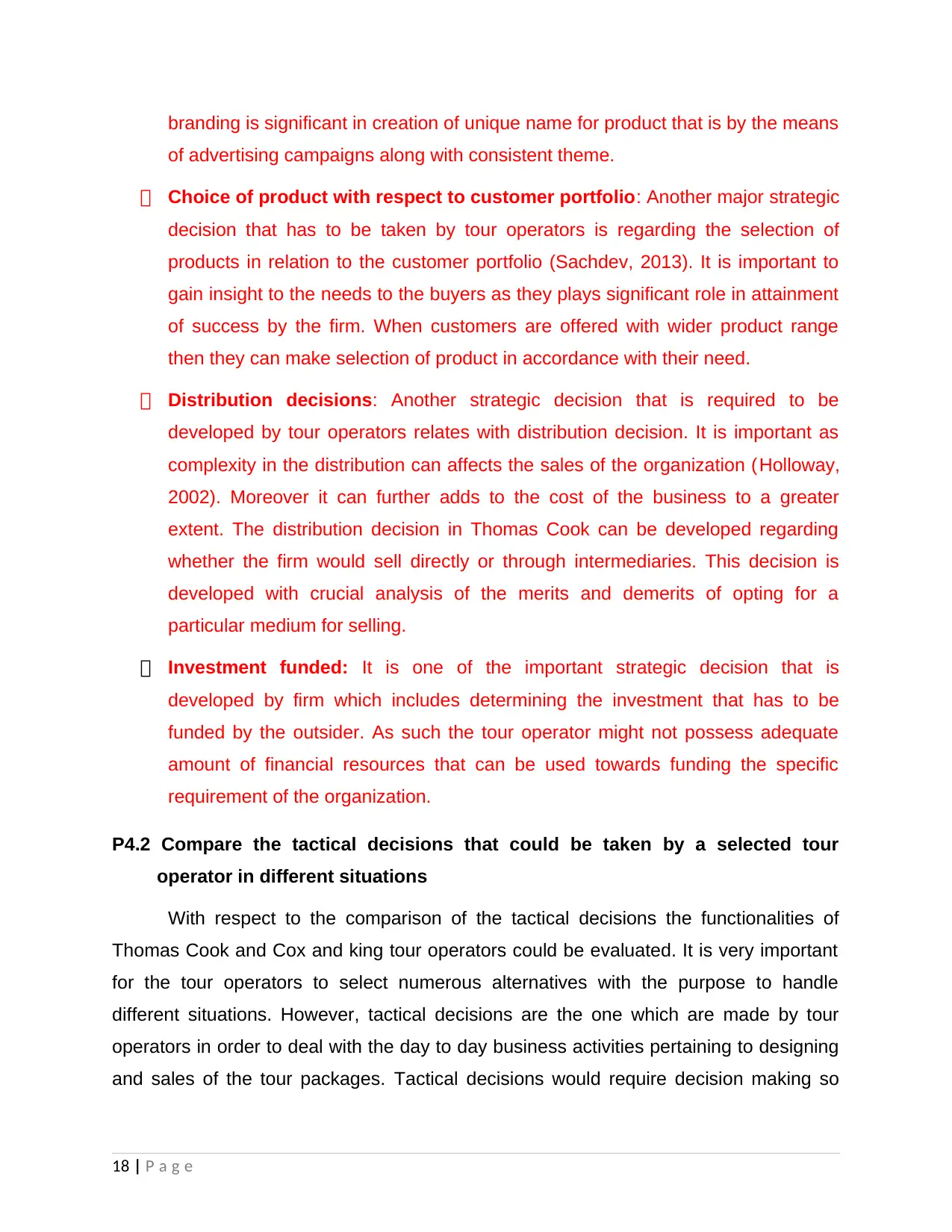
branding is significant in creation of unique name for product that is by the means
of advertising campaigns along with consistent theme.
Choice of product with respect to customer portfolio: Another major strategic
decision that has to be taken by tour operators is regarding the selection of
products in relation to the customer portfolio (Sachdev, 2013). It is important to
gain insight to the needs to the buyers as they plays significant role in attainment
of success by the firm. When customers are offered with wider product range
then they can make selection of product in accordance with their need.
Distribution decisions: Another strategic decision that is required to be
developed by tour operators relates with distribution decision. It is important as
complexity in the distribution can affects the sales of the organization (Holloway,
2002). Moreover it can further adds to the cost of the business to a greater
extent. The distribution decision in Thomas Cook can be developed regarding
whether the firm would sell directly or through intermediaries. This decision is
developed with crucial analysis of the merits and demerits of opting for a
particular medium for selling.
Investment funded: It is one of the important strategic decision that is
developed by firm which includes determining the investment that has to be
funded by the outsider. As such the tour operator might not possess adequate
amount of financial resources that can be used towards funding the specific
requirement of the organization.
P4.2 Compare the tactical decisions that could be taken by a selected tour
operator in different situations
With respect to the comparison of the tactical decisions the functionalities of
Thomas Cook and Cox and king tour operators could be evaluated. It is very important
for the tour operators to select numerous alternatives with the purpose to handle
different situations. However, tactical decisions are the one which are made by tour
operators in order to deal with the day to day business activities pertaining to designing
and sales of the tour packages. Tactical decisions would require decision making so
18 | P a g e
of advertising campaigns along with consistent theme.
Choice of product with respect to customer portfolio: Another major strategic
decision that has to be taken by tour operators is regarding the selection of
products in relation to the customer portfolio (Sachdev, 2013). It is important to
gain insight to the needs to the buyers as they plays significant role in attainment
of success by the firm. When customers are offered with wider product range
then they can make selection of product in accordance with their need.
Distribution decisions: Another strategic decision that is required to be
developed by tour operators relates with distribution decision. It is important as
complexity in the distribution can affects the sales of the organization (Holloway,
2002). Moreover it can further adds to the cost of the business to a greater
extent. The distribution decision in Thomas Cook can be developed regarding
whether the firm would sell directly or through intermediaries. This decision is
developed with crucial analysis of the merits and demerits of opting for a
particular medium for selling.
Investment funded: It is one of the important strategic decision that is
developed by firm which includes determining the investment that has to be
funded by the outsider. As such the tour operator might not possess adequate
amount of financial resources that can be used towards funding the specific
requirement of the organization.
P4.2 Compare the tactical decisions that could be taken by a selected tour
operator in different situations
With respect to the comparison of the tactical decisions the functionalities of
Thomas Cook and Cox and king tour operators could be evaluated. It is very important
for the tour operators to select numerous alternatives with the purpose to handle
different situations. However, tactical decisions are the one which are made by tour
operators in order to deal with the day to day business activities pertaining to designing
and sales of the tour packages. Tactical decisions would require decision making so
18 | P a g e
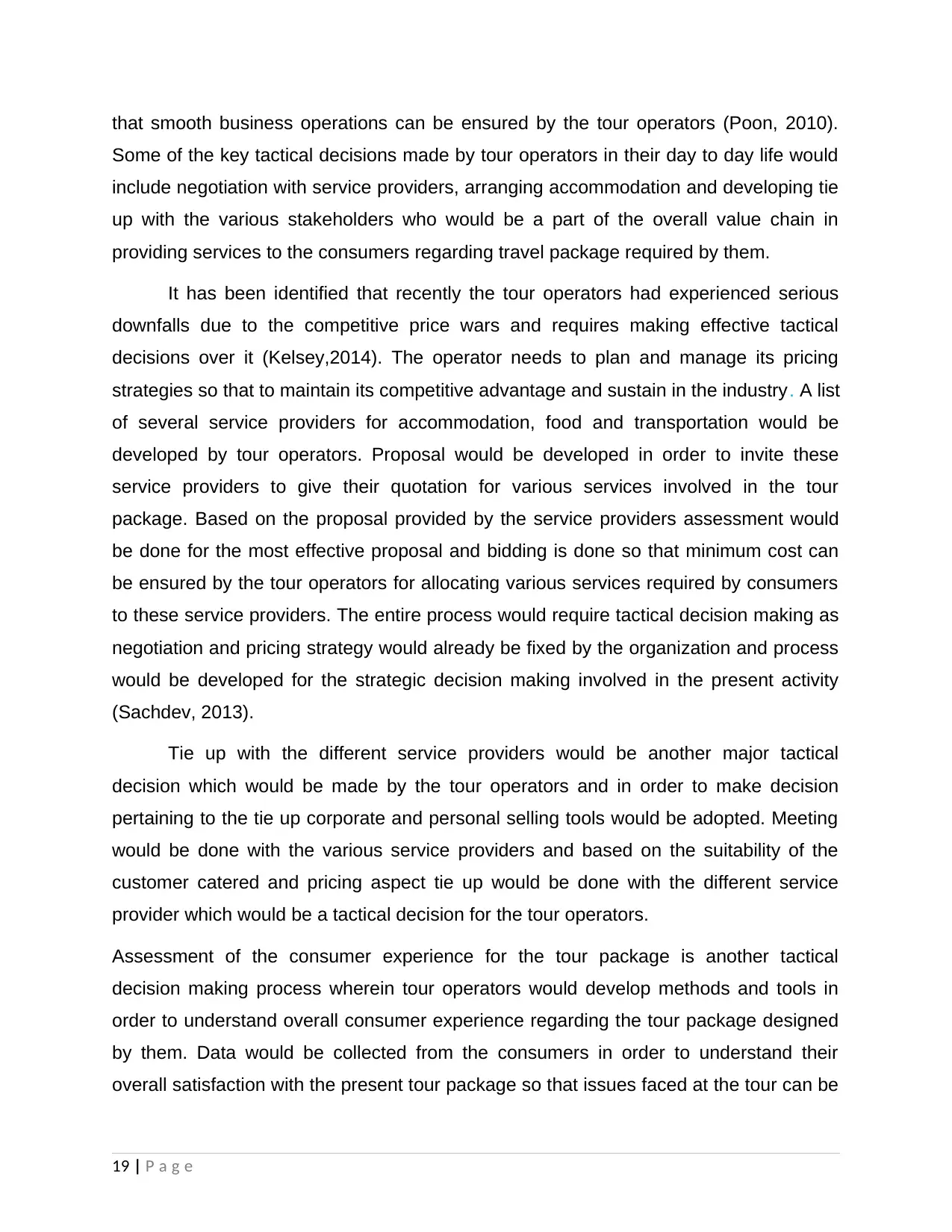
that smooth business operations can be ensured by the tour operators (Poon, 2010).
Some of the key tactical decisions made by tour operators in their day to day life would
include negotiation with service providers, arranging accommodation and developing tie
up with the various stakeholders who would be a part of the overall value chain in
providing services to the consumers regarding travel package required by them.
It has been identified that recently the tour operators had experienced serious
downfalls due to the competitive price wars and requires making effective tactical
decisions over it (Kelsey,2014). The operator needs to plan and manage its pricing
strategies so that to maintain its competitive advantage and sustain in the industry. A list
of several service providers for accommodation, food and transportation would be
developed by tour operators. Proposal would be developed in order to invite these
service providers to give their quotation for various services involved in the tour
package. Based on the proposal provided by the service providers assessment would
be done for the most effective proposal and bidding is done so that minimum cost can
be ensured by the tour operators for allocating various services required by consumers
to these service providers. The entire process would require tactical decision making as
negotiation and pricing strategy would already be fixed by the organization and process
would be developed for the strategic decision making involved in the present activity
(Sachdev, 2013).
Tie up with the different service providers would be another major tactical
decision which would be made by the tour operators and in order to make decision
pertaining to the tie up corporate and personal selling tools would be adopted. Meeting
would be done with the various service providers and based on the suitability of the
customer catered and pricing aspect tie up would be done with the different service
provider which would be a tactical decision for the tour operators.
Assessment of the consumer experience for the tour package is another tactical
decision making process wherein tour operators would develop methods and tools in
order to understand overall consumer experience regarding the tour package designed
by them. Data would be collected from the consumers in order to understand their
overall satisfaction with the present tour package so that issues faced at the tour can be
19 | P a g e
Some of the key tactical decisions made by tour operators in their day to day life would
include negotiation with service providers, arranging accommodation and developing tie
up with the various stakeholders who would be a part of the overall value chain in
providing services to the consumers regarding travel package required by them.
It has been identified that recently the tour operators had experienced serious
downfalls due to the competitive price wars and requires making effective tactical
decisions over it (Kelsey,2014). The operator needs to plan and manage its pricing
strategies so that to maintain its competitive advantage and sustain in the industry. A list
of several service providers for accommodation, food and transportation would be
developed by tour operators. Proposal would be developed in order to invite these
service providers to give their quotation for various services involved in the tour
package. Based on the proposal provided by the service providers assessment would
be done for the most effective proposal and bidding is done so that minimum cost can
be ensured by the tour operators for allocating various services required by consumers
to these service providers. The entire process would require tactical decision making as
negotiation and pricing strategy would already be fixed by the organization and process
would be developed for the strategic decision making involved in the present activity
(Sachdev, 2013).
Tie up with the different service providers would be another major tactical
decision which would be made by the tour operators and in order to make decision
pertaining to the tie up corporate and personal selling tools would be adopted. Meeting
would be done with the various service providers and based on the suitability of the
customer catered and pricing aspect tie up would be done with the different service
provider which would be a tactical decision for the tour operators.
Assessment of the consumer experience for the tour package is another tactical
decision making process wherein tour operators would develop methods and tools in
order to understand overall consumer experience regarding the tour package designed
by them. Data would be collected from the consumers in order to understand their
overall satisfaction with the present tour package so that issues faced at the tour can be
19 | P a g e
Secure Best Marks with AI Grader
Need help grading? Try our AI Grader for instant feedback on your assignments.
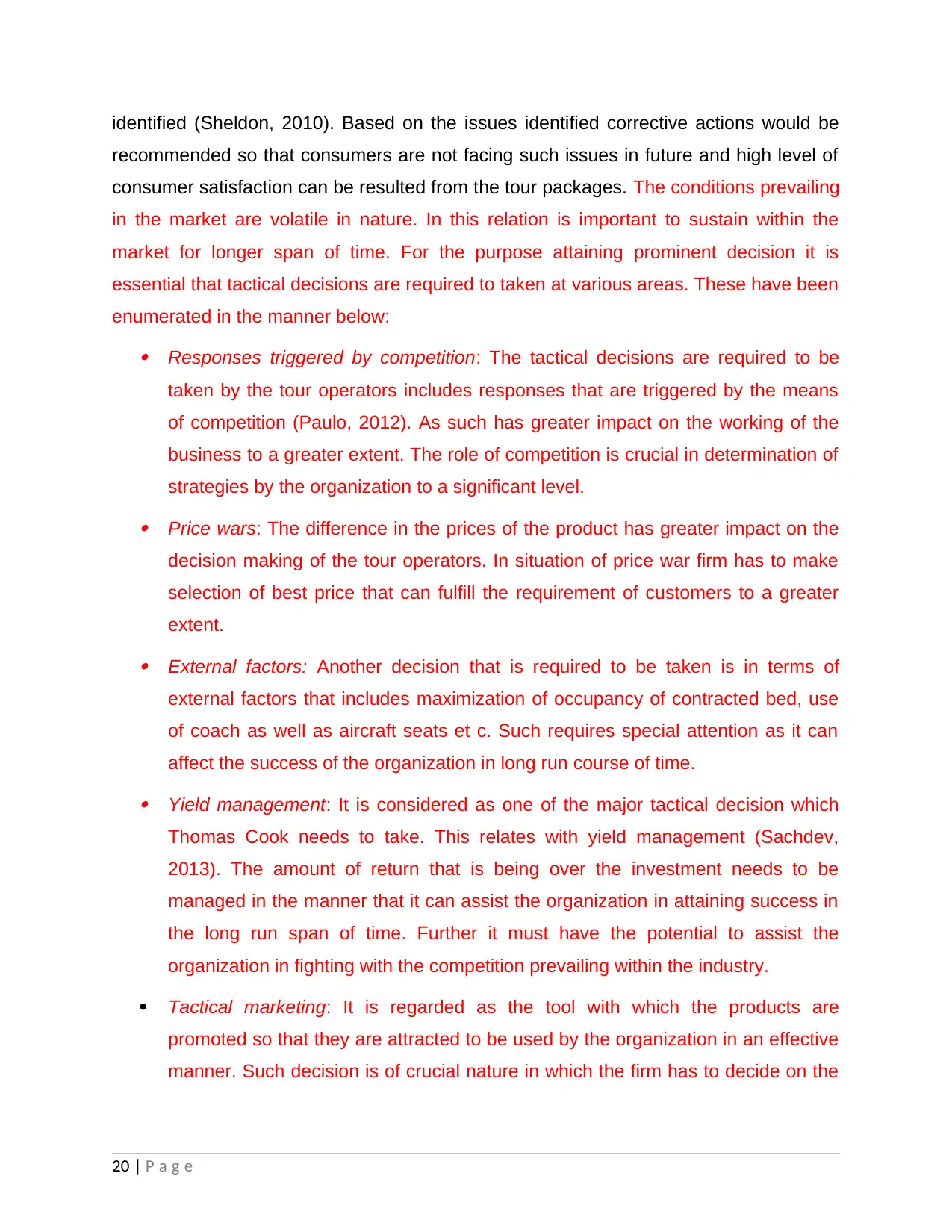
identified (Sheldon, 2010). Based on the issues identified corrective actions would be
recommended so that consumers are not facing such issues in future and high level of
consumer satisfaction can be resulted from the tour packages. The conditions prevailing
in the market are volatile in nature. In this relation is important to sustain within the
market for longer span of time. For the purpose attaining prominent decision it is
essential that tactical decisions are required to taken at various areas. These have been
enumerated in the manner below: Responses triggered by competition: The tactical decisions are required to be
taken by the tour operators includes responses that are triggered by the means
of competition (Paulo, 2012). As such has greater impact on the working of the
business to a greater extent. The role of competition is crucial in determination of
strategies by the organization to a significant level. Price wars: The difference in the prices of the product has greater impact on the
decision making of the tour operators. In situation of price war firm has to make
selection of best price that can fulfill the requirement of customers to a greater
extent. External factors: Another decision that is required to be taken is in terms of
external factors that includes maximization of occupancy of contracted bed, use
of coach as well as aircraft seats et c. Such requires special attention as it can
affect the success of the organization in long run course of time. Yield management: It is considered as one of the major tactical decision which
Thomas Cook needs to take. This relates with yield management (Sachdev,
2013). The amount of return that is being over the investment needs to be
managed in the manner that it can assist the organization in attaining success in
the long run span of time. Further it must have the potential to assist the
organization in fighting with the competition prevailing within the industry.
Tactical marketing: It is regarded as the tool with which the products are
promoted so that they are attracted to be used by the organization in an effective
manner. Such decision is of crucial nature in which the firm has to decide on the
20 | P a g e
recommended so that consumers are not facing such issues in future and high level of
consumer satisfaction can be resulted from the tour packages. The conditions prevailing
in the market are volatile in nature. In this relation is important to sustain within the
market for longer span of time. For the purpose attaining prominent decision it is
essential that tactical decisions are required to taken at various areas. These have been
enumerated in the manner below: Responses triggered by competition: The tactical decisions are required to be
taken by the tour operators includes responses that are triggered by the means
of competition (Paulo, 2012). As such has greater impact on the working of the
business to a greater extent. The role of competition is crucial in determination of
strategies by the organization to a significant level. Price wars: The difference in the prices of the product has greater impact on the
decision making of the tour operators. In situation of price war firm has to make
selection of best price that can fulfill the requirement of customers to a greater
extent. External factors: Another decision that is required to be taken is in terms of
external factors that includes maximization of occupancy of contracted bed, use
of coach as well as aircraft seats et c. Such requires special attention as it can
affect the success of the organization in long run course of time. Yield management: It is considered as one of the major tactical decision which
Thomas Cook needs to take. This relates with yield management (Sachdev,
2013). The amount of return that is being over the investment needs to be
managed in the manner that it can assist the organization in attaining success in
the long run span of time. Further it must have the potential to assist the
organization in fighting with the competition prevailing within the industry.
Tactical marketing: It is regarded as the tool with which the products are
promoted so that they are attracted to be used by the organization in an effective
manner. Such decision is of crucial nature in which the firm has to decide on the
20 | P a g e
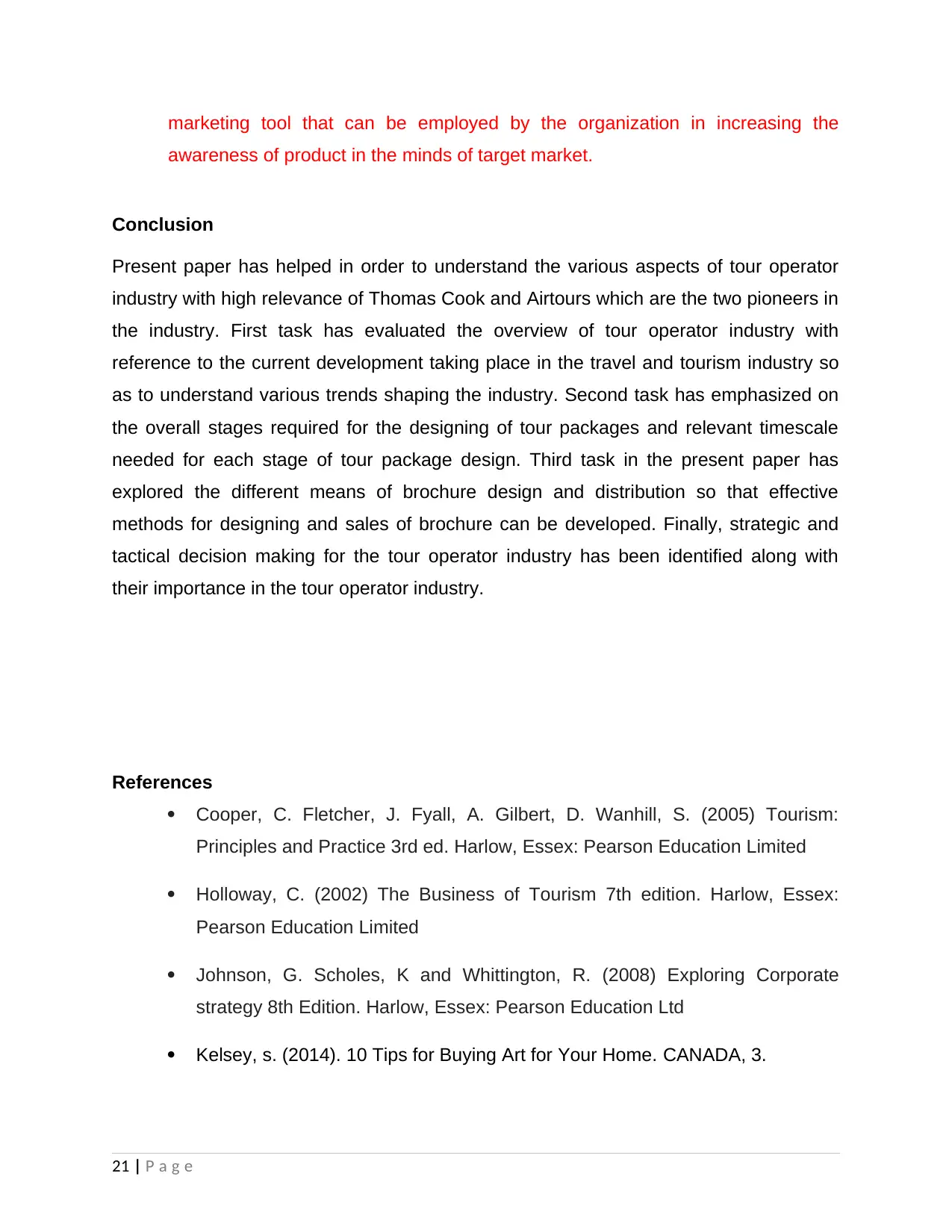
marketing tool that can be employed by the organization in increasing the
awareness of product in the minds of target market.
Conclusion
Present paper has helped in order to understand the various aspects of tour operator
industry with high relevance of Thomas Cook and Airtours which are the two pioneers in
the industry. First task has evaluated the overview of tour operator industry with
reference to the current development taking place in the travel and tourism industry so
as to understand various trends shaping the industry. Second task has emphasized on
the overall stages required for the designing of tour packages and relevant timescale
needed for each stage of tour package design. Third task in the present paper has
explored the different means of brochure design and distribution so that effective
methods for designing and sales of brochure can be developed. Finally, strategic and
tactical decision making for the tour operator industry has been identified along with
their importance in the tour operator industry.
References
Cooper, C. Fletcher, J. Fyall, A. Gilbert, D. Wanhill, S. (2005) Tourism:
Principles and Practice 3rd ed. Harlow, Essex: Pearson Education Limited
Holloway, C. (2002) The Business of Tourism 7th edition. Harlow, Essex:
Pearson Education Limited
Johnson, G. Scholes, K and Whittington, R. (2008) Exploring Corporate
strategy 8th Edition. Harlow, Essex: Pearson Education Ltd
Kelsey, s. (2014). 10 Tips for Buying Art for Your Home. CANADA, 3.
21 | P a g e
awareness of product in the minds of target market.
Conclusion
Present paper has helped in order to understand the various aspects of tour operator
industry with high relevance of Thomas Cook and Airtours which are the two pioneers in
the industry. First task has evaluated the overview of tour operator industry with
reference to the current development taking place in the travel and tourism industry so
as to understand various trends shaping the industry. Second task has emphasized on
the overall stages required for the designing of tour packages and relevant timescale
needed for each stage of tour package design. Third task in the present paper has
explored the different means of brochure design and distribution so that effective
methods for designing and sales of brochure can be developed. Finally, strategic and
tactical decision making for the tour operator industry has been identified along with
their importance in the tour operator industry.
References
Cooper, C. Fletcher, J. Fyall, A. Gilbert, D. Wanhill, S. (2005) Tourism:
Principles and Practice 3rd ed. Harlow, Essex: Pearson Education Limited
Holloway, C. (2002) The Business of Tourism 7th edition. Harlow, Essex:
Pearson Education Limited
Johnson, G. Scholes, K and Whittington, R. (2008) Exploring Corporate
strategy 8th Edition. Harlow, Essex: Pearson Education Ltd
Kelsey, s. (2014). 10 Tips for Buying Art for Your Home. CANADA, 3.
21 | P a g e
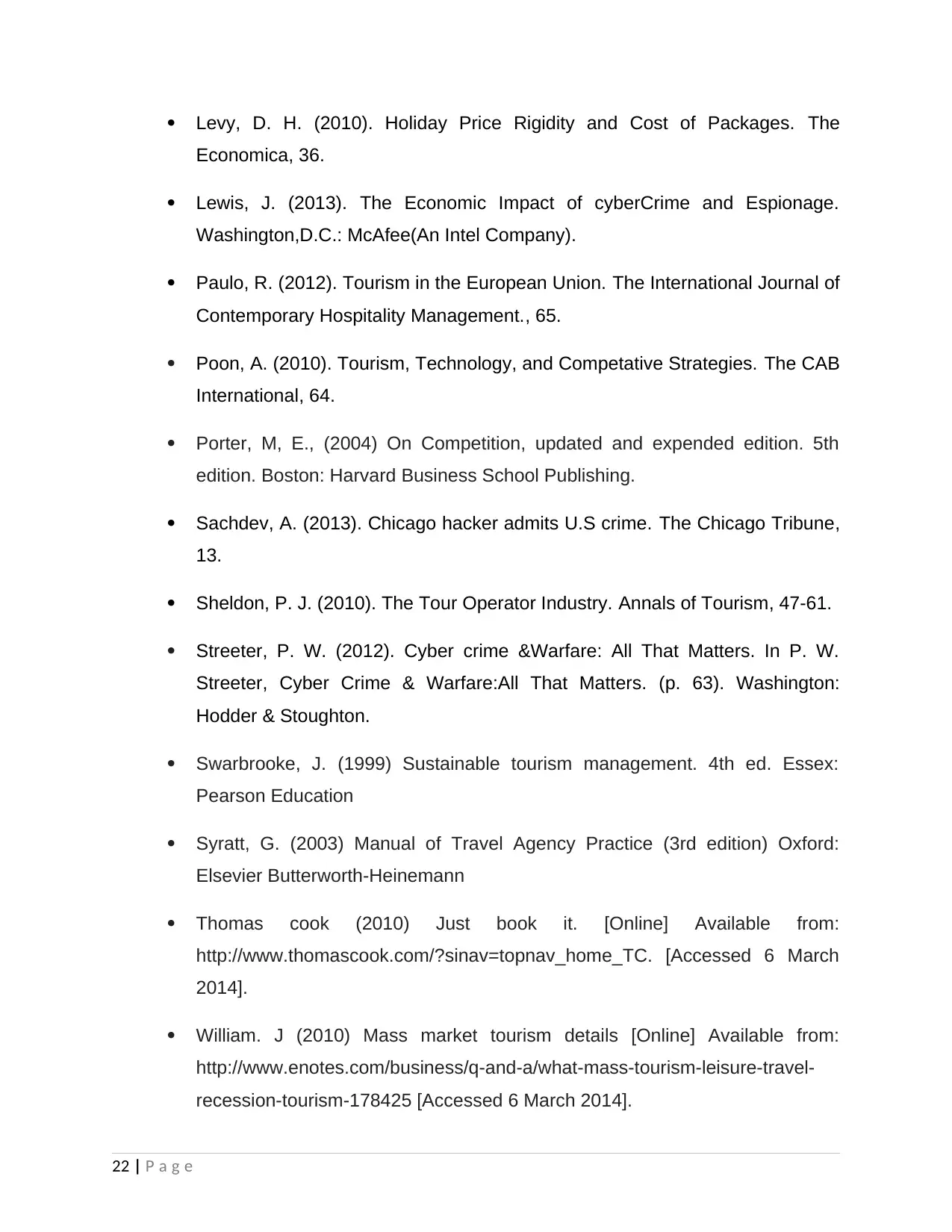
Levy, D. H. (2010). Holiday Price Rigidity and Cost of Packages. The
Economica, 36.
Lewis, J. (2013). The Economic Impact of cyberCrime and Espionage.
Washington,D.C.: McAfee(An Intel Company).
Paulo, R. (2012). Tourism in the European Union. The International Journal of
Contemporary Hospitality Management., 65.
Poon, A. (2010). Tourism, Technology, and Competative Strategies. The CAB
International, 64.
Porter, M, E., (2004) On Competition, updated and expended edition. 5th
edition. Boston: Harvard Business School Publishing.
Sachdev, A. (2013). Chicago hacker admits U.S crime. The Chicago Tribune,
13.
Sheldon, P. J. (2010). The Tour Operator Industry. Annals of Tourism, 47-61.
Streeter, P. W. (2012). Cyber crime &Warfare: All That Matters. In P. W.
Streeter, Cyber Crime & Warfare:All That Matters. (p. 63). Washington:
Hodder & Stoughton.
Swarbrooke, J. (1999) Sustainable tourism management. 4th ed. Essex:
Pearson Education
Syratt, G. (2003) Manual of Travel Agency Practice (3rd edition) Oxford:
Elsevier Butterworth-Heinemann
Thomas cook (2010) Just book it. [Online] Available from:
http://www.thomascook.com/?sinav=topnav_home_TC. [Accessed 6 March
2014].
William. J (2010) Mass market tourism details [Online] Available from:
http://www.enotes.com/business/q-and-a/what-mass-tourism-leisure-travel-
recession-tourism-178425 [Accessed 6 March 2014].
22 | P a g e
Economica, 36.
Lewis, J. (2013). The Economic Impact of cyberCrime and Espionage.
Washington,D.C.: McAfee(An Intel Company).
Paulo, R. (2012). Tourism in the European Union. The International Journal of
Contemporary Hospitality Management., 65.
Poon, A. (2010). Tourism, Technology, and Competative Strategies. The CAB
International, 64.
Porter, M, E., (2004) On Competition, updated and expended edition. 5th
edition. Boston: Harvard Business School Publishing.
Sachdev, A. (2013). Chicago hacker admits U.S crime. The Chicago Tribune,
13.
Sheldon, P. J. (2010). The Tour Operator Industry. Annals of Tourism, 47-61.
Streeter, P. W. (2012). Cyber crime &Warfare: All That Matters. In P. W.
Streeter, Cyber Crime & Warfare:All That Matters. (p. 63). Washington:
Hodder & Stoughton.
Swarbrooke, J. (1999) Sustainable tourism management. 4th ed. Essex:
Pearson Education
Syratt, G. (2003) Manual of Travel Agency Practice (3rd edition) Oxford:
Elsevier Butterworth-Heinemann
Thomas cook (2010) Just book it. [Online] Available from:
http://www.thomascook.com/?sinav=topnav_home_TC. [Accessed 6 March
2014].
William. J (2010) Mass market tourism details [Online] Available from:
http://www.enotes.com/business/q-and-a/what-mass-tourism-leisure-travel-
recession-tourism-178425 [Accessed 6 March 2014].
22 | P a g e
1 out of 22
Related Documents
Your All-in-One AI-Powered Toolkit for Academic Success.
+13062052269
info@desklib.com
Available 24*7 on WhatsApp / Email
![[object Object]](/_next/static/media/star-bottom.7253800d.svg)
Unlock your academic potential
© 2024 | Zucol Services PVT LTD | All rights reserved.





